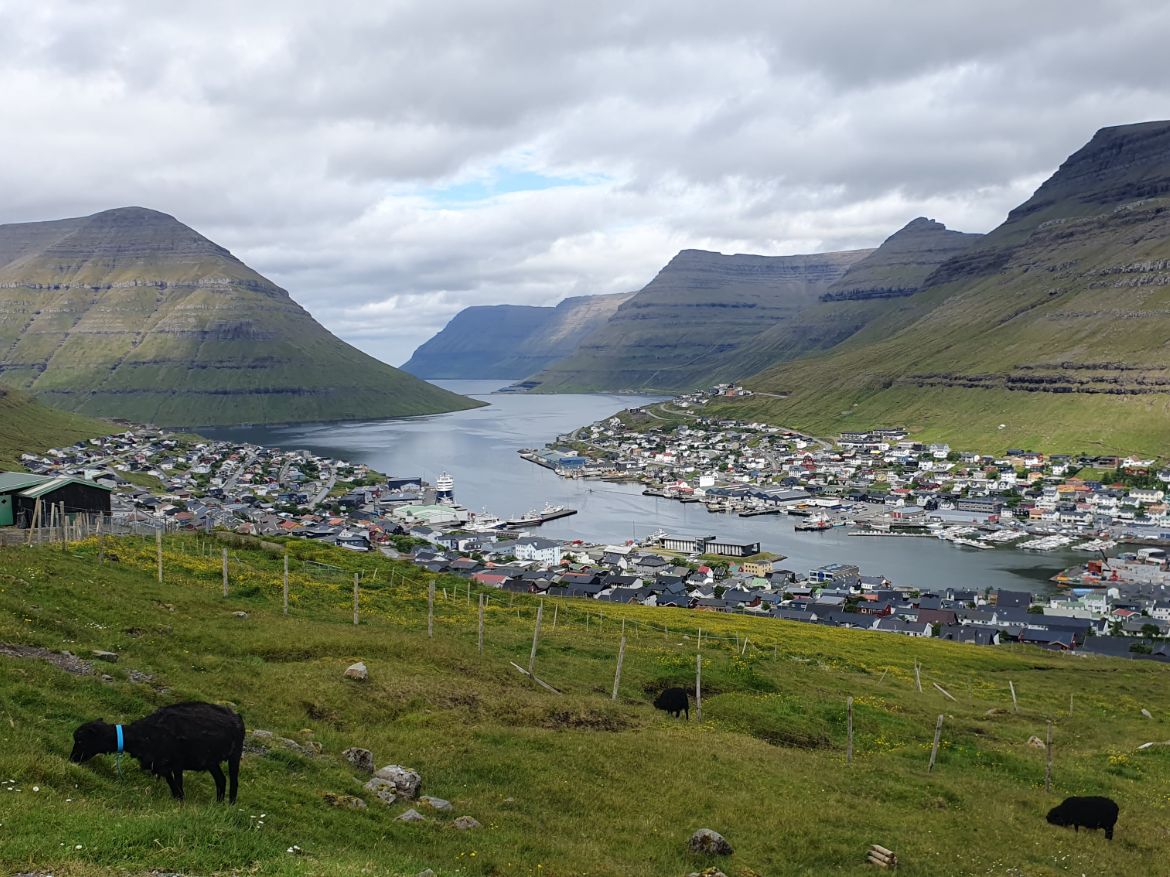The Faroe Islands are an archipelago in the North Atlantic Ocean, roughly halfway between Norway and Iceland. They are an autonomous territory of Denmark with its own government and language.
Faroe Islands are known for their remoteness, dramatic scenery, rich wildlife and distinct culture. It is a magical place to visit with out-of-this-world scenery and without the tourist crowds.
It is the perfect destination for travellers looking for epic landscapes and a sense of adventure. However, you must be ready for unpredictable weather and comfortable with a high budget.
This travel guide will help you plan the perfect trip to the Faroe Islands by showing you the top attractions and best things to do as well as the best activities & hiking trails including a detailed map, photos and itinerary.
- INTRODUCTION TO FAROE ISLANDS
- BEST TIME TO VISIT FAROE ISLANDS
- HOW LONG TO STAY IN FAROE ISLANDS
- WHERE TO STAY IN FAROE ISLANDS
- PRACTICAL INFORMATION
- HOW TO GET TO THE FAROE ISLANDS
- HOW TO GET AROUND THE FAROE ISLANDS
- WHAT TO EAT & DRINK IN FAROE ISLANDS
- THINGS TO DO IN FAROE ISLANDS
- FAROE ISLANDS BEST TOWNS & VILLAGES
- FAROE ISLANDS BEST BEACHES
- FAROE ISLANDS TOURIST MAP
- FAROE ISLANDS ITINERARY
- FAROE ISLANDS PHOTOGRAPHY
- FAROE ISLANDS ACTIVITIES
- FAROE ISLANDS TOURS
- VIRTUAL TOUR OF FAROE ISLANDS
- SHOPPING IN FAROE ISLANDS
- FURTHER READING
- TRAVEL RESOURCES
INTRODUCTION TO FAROE ISLANDS
Why visit the Faroe Islands
The Faroe Islands is an archipelago of 18 rugged and windswept islands and a population of about 50,000 people. The largest island, Streymoy, is home to the capital, Tórshavn.
While the Faroe Islands are part of the Kingdom of Denmark, they operate with considerable self-governance.
Faroese culture is connected to the Norse traditions and the Vikings. The Faroese language, a North Germanic language closely related to Icelandic, is the national language, though Danish and English are also widely spoken.
The economy of the Faroe Islands is dependent on the fishing industry, which accounts for a significant portion of the GDP and exports. Tourism has also grown in importance, attracting visitors to the islands’ natural beauty and unique culture.
Whaling is still legal in the Faroes Islands and pilot whales and dolphins are killed for their meat, which, along with the blubber, is eaten in homes. Whale hunting is a controversial issue, but it still takes place based on the same tradition since ancient times.
The weather in the Faroe Islands is unpredictable, with frequent changes throughout the day. The climate is oceanic, meaning it’s generally cool, wet, and windy year-round. When you plan your trip, you need to be ready to change your plans according to the weather conditions.
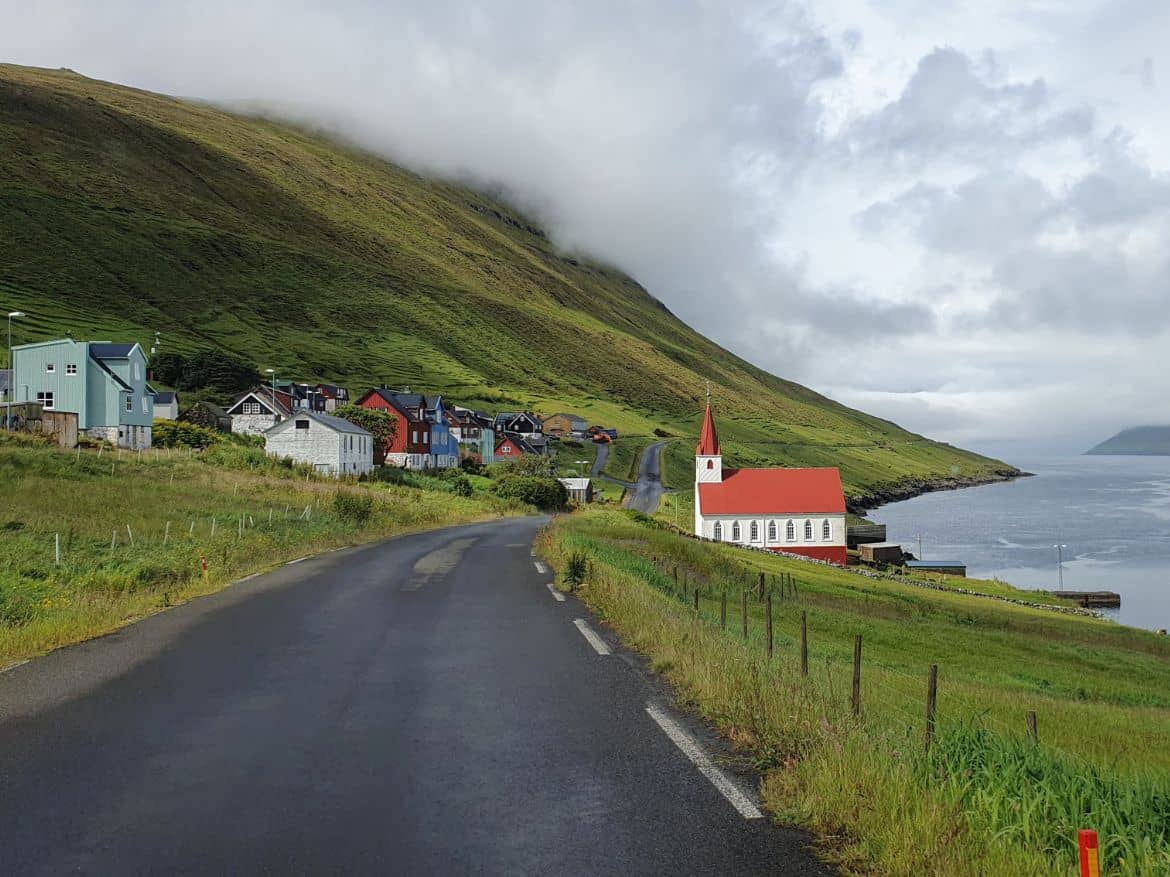
The Faroe Islands are famous for their dramatic scenery: steep cliffs, deep fjords, rolling green hills, and rugged coastlines. The landscape is breathtaking and ideal for hiking, scenic drives and photography.
The islands offer some of the most picturesque and unspoiled landscapes in the world. Popular sights include the iconic Múlafossur waterfall, the sea cliffs of Vestmanna, Kalsoy with its famous lighthouse and the villages of Saksun and Gjógv.
The islands are a hiker’s paradise, with trails that take you through remote valleys, up steep mountains, and along cliff edges offering panoramic views. Hikes like those to Trælanípan, where you can see the illusion of a “floating lake,” or to the summit of Slættaratindur, the highest peak, are among the most popular.
Faroe Islands are also popular for birdwatching, as they are home to large colonies of seabirds, including puffins, guillemots, and gannets. The islands are also a great place to spot seals and, occasionally, pilot whales. The island of Mykines is especially famous for its birdlife.
One of the main reasons to visit the Faroe Islands is the peace and solitude they offer, as mass tourism hasn’t arrived here yet. and they feel almost unspoilt.
The islands are a popular destination for solo travellers, including women, due to the safety and tranquillity they offer.
However, be aware that this is an expensive destination. Car rental, accommodation, hiking fees and the tolls of the underwater tunnels connecting the various islands can be overwhelming.
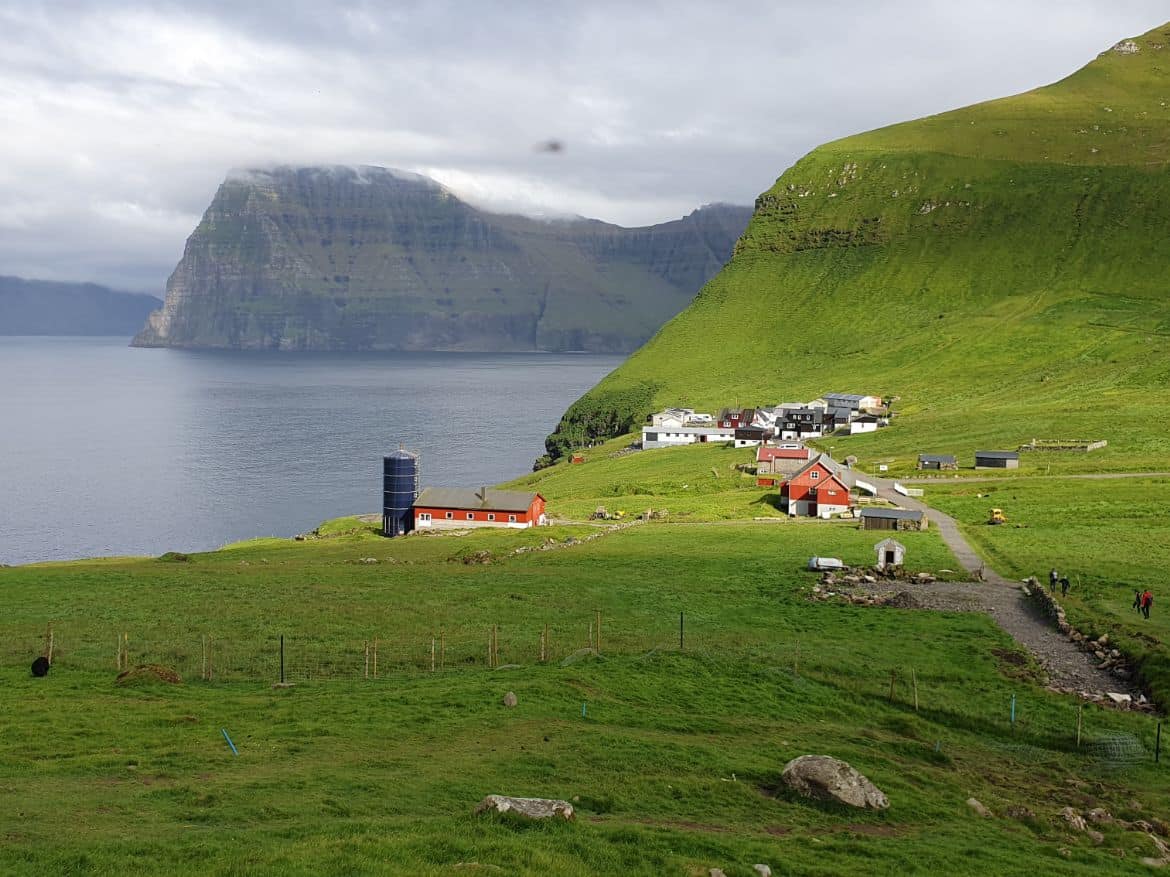
BEST TIME TO VISIT FAROE ISLANDS
The best time to visit the Faroe Islands is generally from June to August. During this period, the weather is milder with temperatures from 10°C to 15°C, and days are longer.
Also during the summer months, the landscape is beautifully green; trails are more accessible, and the weather is generally more stable, ideal for hiking, birdwatching and boat tours.
However, the weather on the islands can be very unpredictable and you need to be prepared for rain, fog and strong winds any time of the year. Visitors to the Faroes should pack accordingly, with layers, waterproofs, and windproof clothing.
For me, June and July are the best months to visit the islands as it is warmer and with the longest daylight hours; with nearly 19 hours of daylight, you have plenty of time to explore. It is also the best time for birdwatching, as puffins, gannets, and other seabirds nest.
April to May or September to October are still good, with enough daylight, if you prefer fewer crowds, the yellow colours of the landscape and a sense of solitude.
Visiting in winter (November to March), the weather can be very harsh with limited daylight hours. Some roads and hiking trails may be closed, and outdoor activities are more restricted. However, on clear nights, there’s a chance to see the Northern Lights, though it’s not as frequent as in Iceland or Norway.
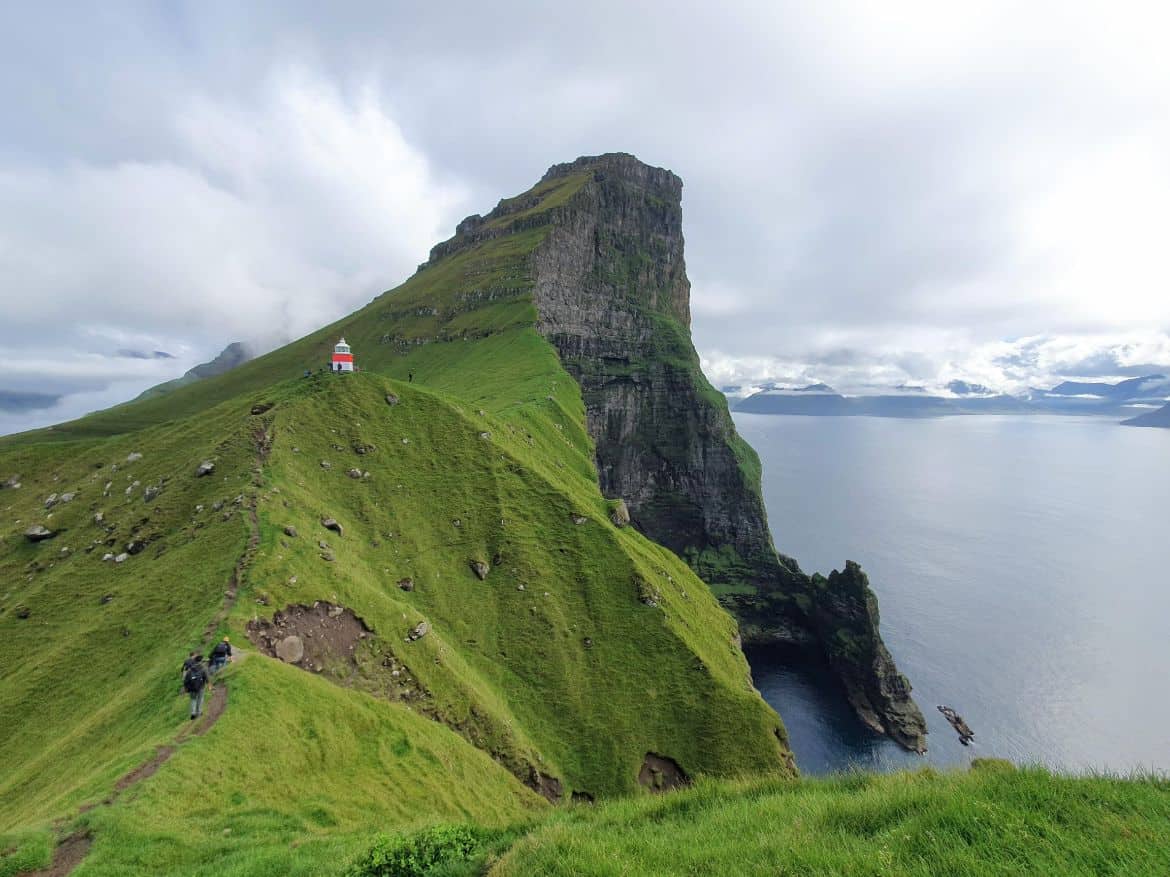
HOW LONG TO STAY IN FAROE ISLANDS
The ideal length of stay in the Faroe Islands depends on how much you want to explore and spend time hiking. However, a stay of 5 to 7 days is generally recommended to experience the main highlights and the island’s remote beauty.
Faroe Islands have so many amazing places to explore, so I would recommend a minimum stay of 5 days if you would like to explore the main islands: Streymoy, Vagar, Mykines, Eysturoy and the Northern Isles.
You will need more than a week if you also want to explore the southern islands of Sandoy and Suduroy.
Keep in mind that the weather in the Faroe Islands can be unpredictable, so it’s good to have a flexible itinerary. Extra days allow you to reschedule outdoor activities if necessary due to weather conditions.
You can have a look at the suggested itinerary here.
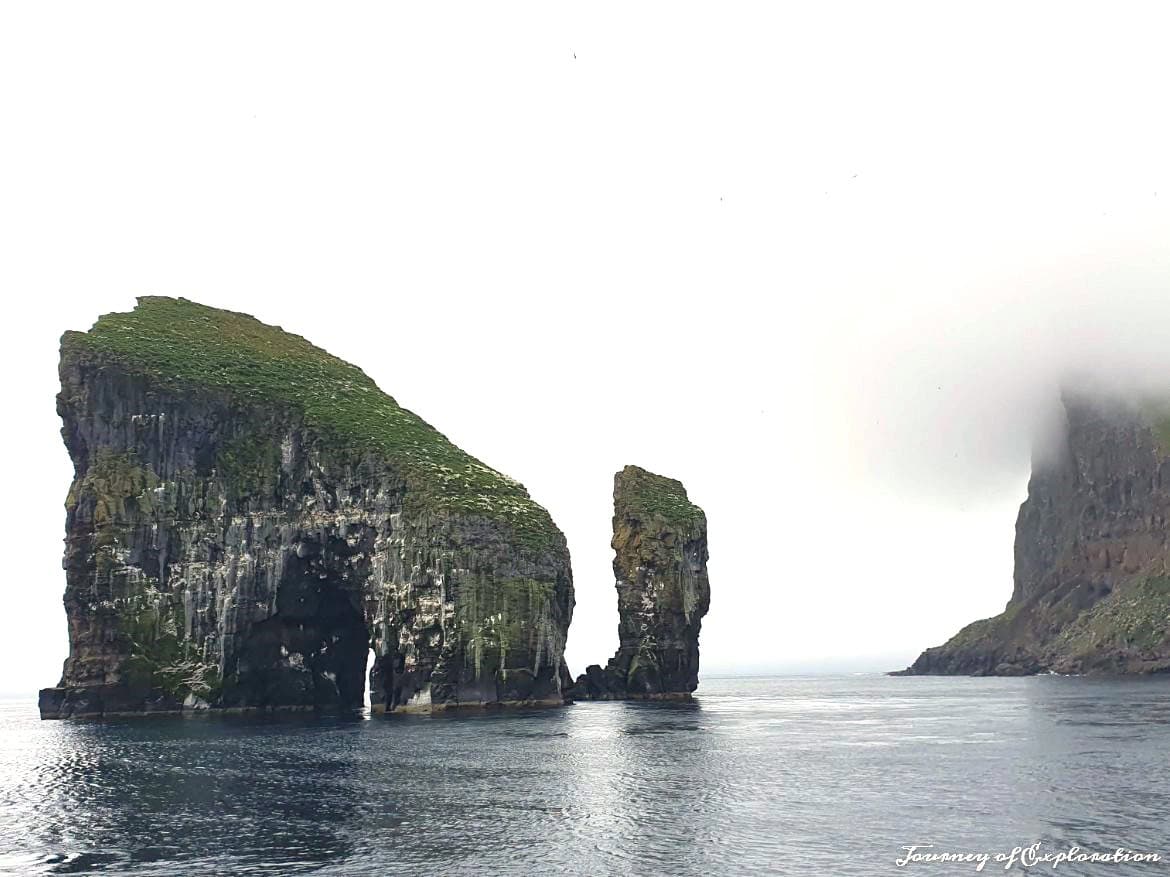
WHERE TO STAY IN FAROE ISLANDS
The most popular place to stay in the Faroe Islands is the capital Tórshavn, with several hotels and guesthouses offering convenient access to amenities and attractions.
Klaksvík, the second biggest town on the islands, offers a few amenities and it is a good base to explore the Northern Isles and Kalsoy.
Other villages such as Sandavágur, and Sørvágur in Vagar are another option. They offer a few hotels and guesthouses, but limited options for food and shopping. It is a good base for Mykines and exploring Vagar.
For me, Tórshavn is the best place to stay with most accommodation options, tourist amenities and restaurants. It is also well located to explore the rest of the islands, especially if you don’t have your own transport.
It might be worth staying in different places on the islands if you are comfortable with some nights in Torshavn, a night or two in Klaksvik and a night in Vagar island. This way you reduce the driving distances and also save on the tolls of underwater tunnels.
Accommodation options (especially hotels) are in short supply on the islands and quite expensive. Booking in advance, especially during the peak tourist season, is advisable to get the best prices.
Best hotels in the Faroe Islands
- Hotel Føroyar: A modern, upscale hotel with stunning views over Tórshavn and the surrounding landscape. It offers comfortable rooms and a good restaurant.
- Havgrím Seaside Hotel 1948: A boutique hotel located right by the sea, offering elegant rooms with a mix of traditional Faroese and modern design.
- Hotel Djurhuus: A modern hotel located close to the city centre of Tórshavn, offering good value with a contemporary design and a good buffet breakfast.
- 62N Hotel: A mid-range hotel with a bar and a restaurant in Torshavn. It’s ideal for travellers who want a central location without breaking the bank.
- Hotel Tórshavn: A more budget-friendly option located in the heart of Tórshavn, close to restaurants, shops, and the harbour.
- Hotel Vágar: Located near the airport in Sørvágur, this hotel is convenient for those arriving late or leaving early. It’s a simple, comfortable option.
- Gjáargarður Guesthouse (Gjógv): A charming guesthouse located in the picturesque village of Gjógv. It’s perfect for hikers and people looking for isolation.
- Hotel Runavík: A comfortable hotel located in Runavík, offering easy access to the Northern Isles.
- Hotel Klaksvík: The main hotel in Klaksvík offering a convenient base for exploring the Northern Isles.
- GiljaHome: Situated in Sandavágur, it is one of the cheapest accommodation options; rooms in a house with shared bathrooms and free private parking.
Click here to check and compare prices on accommodation in the Faroe Islands. You can find the best hotels on this map.
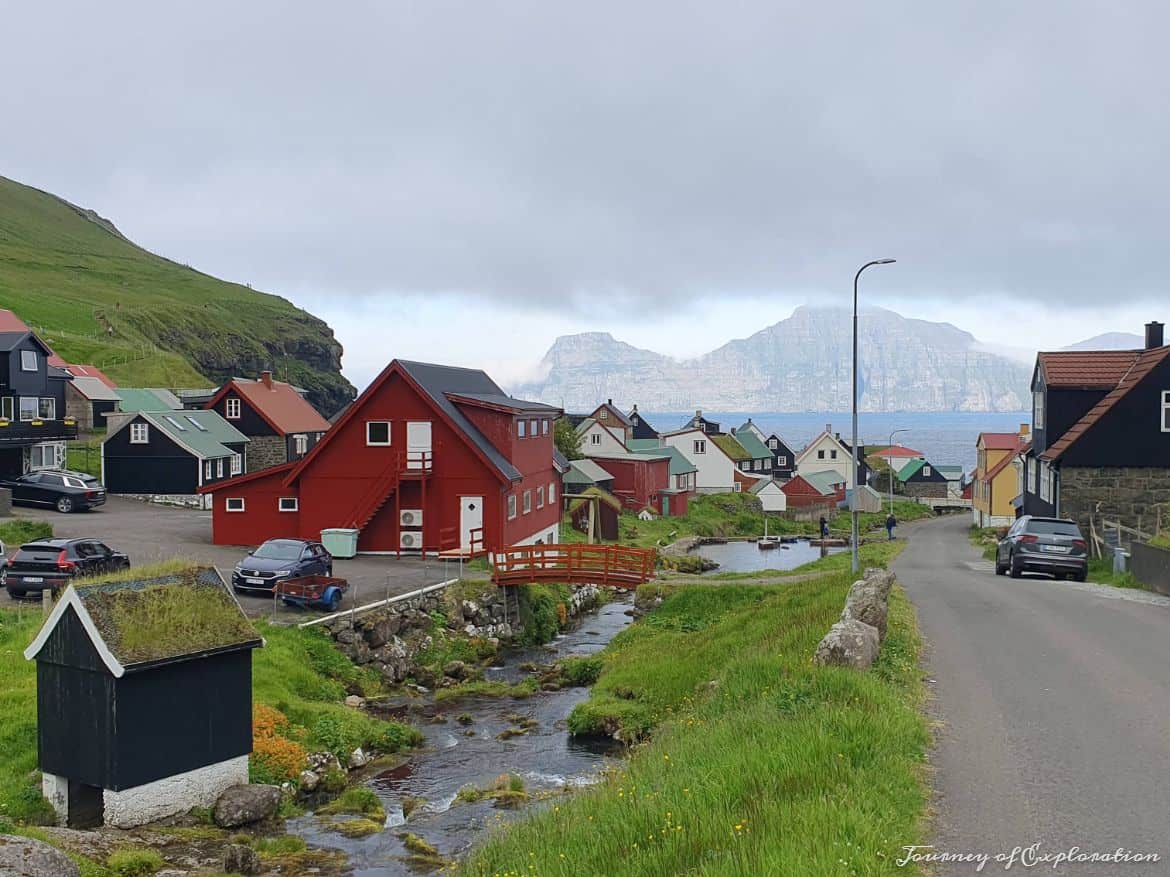
PRACTICAL INFORMATION
Entry Requirements/Visa
The Faroe Islands are part of the Kingdom of Denmark but are not a member of the European Union (EU) or the Schengen Area. However, the visa and entry requirements for the Faroe Islands are similar to those for Denmark,
Citizens from most of Europe, the United States, Canada, Australia, and Japan, can visit the Faroe Islands for up to 3 months without a visa for tourism purposes.
The nationalities requiring a visa for entering the Faroe Islands are the same as for Denmark and can be found here.
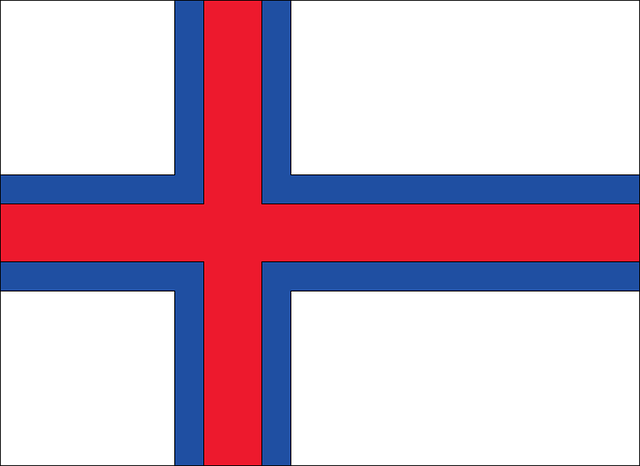
Safety
Faroe Islands are considered a safe destination, so you shouldn’t come across any issues during your stay.
The Faroe Islands have one of the lowest crime rates in the world. Violent crime is extremely rare, and petty crimes like theft are also uncommon. The close-knit community and remote nature of the islands contribute to this low level of crime.
The biggest safety concern in the Faroe Islands is the unpredictable weather. The islands are known for sudden changes in weather conditions, with frequent strong winds, rain and fog, which can affect outdoor activities like hiking and sailing.
If hiking or exploring off the beaten path, inform someone of your plans, stay on marked trails, carry a map or a GPS device, and a portable mobile charger and be prepared for emergencies.
Care should also be taken when driving, as roads can be narrow, winding, and occasionally impacted by fog, rain, or sheep wandering onto the road
Travel Insurance
It’s always advisable to get travel insurance. You never know what might happen; better to be fully covered in case of an accident, medical emergency or flight delays.
Faroe Islands is not part of the EU and therefore you need proper travel insurance, even if you are travelling from Europe, to avoid the high hospital cost in case of emergency.
SafetyWing is an excellent choice for long-term travellers. Alternatively, you can use one of the price comparison websites for cheaper quotes.
Weather
The Faroe Islands have a subpolar oceanic climate, characterized by cool temperatures, high humidity, frequent rain and strong winds throughout the year. Despite being located at a high latitude, the islands experience relatively mild temperatures due to the influence of the Gulf Stream.
The Faroe Islands receive a lot of rainfall, spread evenly throughout the year. On average, there are about 200-250 rainy days annually.
The rainiest period is typically from September to January.
Fog and mist are very common and can blanket the islands, especially in the higher elevations and coastal areas.
Summer (June to August): Average temperatures range from 10°C to 13°C (50°F to 55°F). Summers are cool, and while there can be occasional warm days, temperatures rarely exceed 16°C (61°F). Evenings can be chilly. Very long days, almost 19 hours of daylight in June, with twilight lasting most of the night.
Winter (December to February): Average temperatures range from 2°C to 6°C (36°F to 43°F). Winters are mild compared to other places at similar latitudes, with temperatures rarely dropping below freezing. Snow is possible but not common, and when it does occur, it usually melts quickly.
Spring (March to May) and Autumn (September to November): Spring and autumn are transitional seasons with temperatures ranging from 5°C to 10°C (41°F to 50°F). These seasons can be quite variable, with a mix of mild and cool days, and frequent rain.
You can check historical weather data here.
You can download the Faroe Islands Live app, which provides live webcams from villages and towns in the Faroe Islands. Very useful for up-to-date information on the weather in various locations around the island.
Language
The official language of the Faroe Islands is Faroese.
Faroese is a North Germanic language closely related to Icelandic and, to a lesser extent Norwegian. It evolved from Old Norse, the language spoken by the Vikings. Faroese is the primary language used in government, education, and media within the Faroe Islands.
Most Faroese people are also fluent in Danish and often speak English well. Danish is taught in schools as a second language.
English is widely spoken, especially in tourist areas, hotels, and restaurants.
Money
The currency used in the Faroe Islands is the Faroese króna (FKR), abbreviated as kr.
The Faroese króna is pegged to the Danish króna (DKK) and is used exclusively in the Faroe Islands.
Credit and debit cards are accepted almost everywhere across the Faroe Islands, even for hiking fees, ferries, hotels, shops, and many small businesses. Visa and MasterCard are the most commonly accepted cards.
The best place to exchange some money is through an ATM that can be found in Tórshavn and a few other towns.
Tipping is not obligatory in the Faroe Islands, as service charges are generally included in the bill.
The Faroe Islands can be expensive compared to many other destinations. Prices for food, accommodation, and services can be higher than in other European countries due to the island’s remote location and import costs.
Electricity
In the Faroe Islands, the electricity system is similar to that of Denmark and most other European countries; the standard voltage is 230 volts and frequency 50Hz.
The Faroe Islands use Type C and Type K plugs. If you’re travelling from the UK or outside of Europe, you will need a plug adaptor to use your electronic devices in the Faroe Islands.
Packing List
- Waterproof Jacket/Trousers & Footwear to stay dry during outdoor activities.
- Warm Layers, as temperatures can be chilly, especially in the evenings.
- Hood, scarf and gloves for cold and wind protection
- Hiking Boots
- Backpack
- Binoculars for birdwatching and wildlife viewing
- Travel Adaptor
- Portable Charger (powerbank)
- A small durable umbrella
- Sun Protection: sunscreen, sunglasses, and a hat
- First Aid Kit: bandages, antiseptic wipes, painkillers
For more information on travel gear and what to pack click below.
Internet/Mobile Phone
Most accommodations, including hotels, guesthouses, and cafes, offer free Wi-Fi. Public places like airports and some public transportation also have Wi-Fi access.
To avoid roaming charges, you can buy a local SIM card at the airport, in telecom stores, or in some convenience stores. This can be a good option if you need local data or call services outside of your accommodation.
Be aware that the Faroe Islands are not part of EU and roaming charges apply even for EU tourists.
The main mobile operators in the Faroe Islands are Føroya Tele and Hey. Each offers a range of prepaid plans, data bundles, and other mobile services. Mobile network coverage is generally good in urban areas and along main roads but coverage may be limited in more remote or rural areas.
It’s worth downloading offline maps or navigation apps to your smartphone before arriving in the Faroe Islands, as GPS signal and internet access may be limited in some areas.
Airalo is also a good option as it provides access to eSIMs (digital SIM cards) for over 200 countries. Travellers can download and install a digital data pack and get free internet without roaming charges. However, Airalo is compatible with only the latest mobile phones.
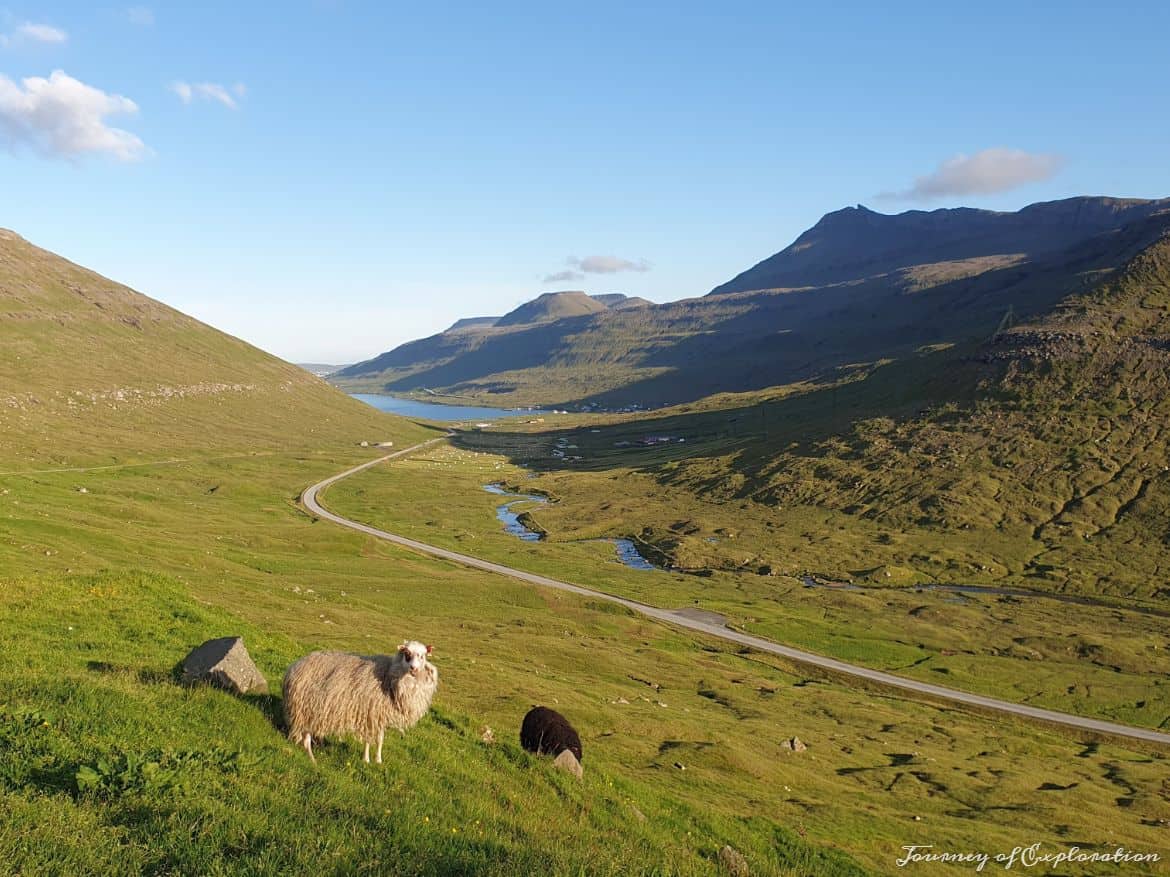
HOW TO GET TO THE FAROE ISLANDS
By Plane
Vágar Airport (FAE) is the primary international airport serving the Faroe Islands. It is located on the island of Vágar, which
is connected to the other islands by tunnels and bridges.
Direct flights to Vágar Airport are available from Copenhagen and Billund in Denmark. These are the most frequent and convenient options.
There are also direct flights from Iceland (Reykjavik), Norway (Oslo & Bergen), Edinburgh and Paris.
If you are travelling from outside of these countries you will likely need to connect through one of these hubs (Copenhagen, Reykjavik, Oslo) for a direct flight to Vágar Airport.
The main airlines serving the islands are Atlantic Airways, the national carrier of the Faroe Islands, and SAS (Scandinavian Airlines).
Getting from/to the airport
The airport is located in Vagar Island about 46km south of Tórshavn. Upon your arrival, you can hire a car (highly recommended) in one of the rental offices at the airport. The airport is the best place to book if you haven’t done it before you arrive. The journey to Torshavn by car takes about 45min.
There is also an airport shuttle service that connects Vágar Airport to Tórshavn. The shuttle operates regularly and can be booked in advance.
Taxis are available at the airport taxi stand. It’s a good idea to confirm the fare and destination with the driver before departing. Taxi rides to Tórshavn generally cost around 800 to 1,000 DKK (approximately 105 to 135 EUR). You can also book a taxi in advance here.
There is also a public bus (300) connecting Vágar Airport with Sorgavur and Torshavn, but it has a limited schedule and does not operate as frequently, so check the timetable in advance.
By Ferry
Smyril Line operates overnight ferry services from Hirtshals in Denmark to Sørvágur (on Vágar Island). The journey takes about 36 hours.
Smyril Line also provides ferry services from Seydisfjördur in Iceland to the Faroe Islands (Sorvagur). This journey takes around 18 hours.
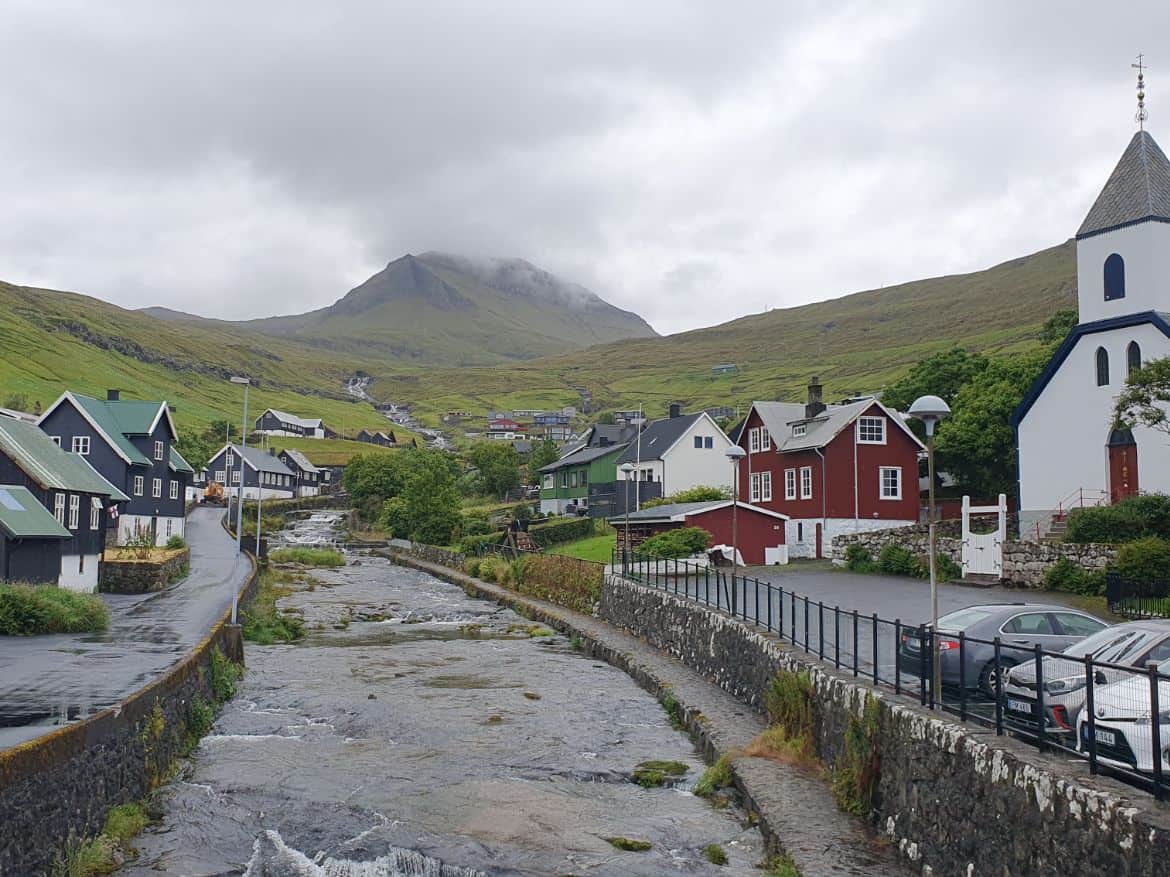
HOW TO GET AROUND THE FAROE ISLANDS
By Car
I would recommend hiring a car if you would like to explore the Faroe Islands, as it gives you the freedom to explore more remote areas and stop wherever you like to appreciate the views and take photos.
Car rental agencies are available at Vágar Airport and in larger towns like Tórshavn. It’s advisable to book in advance, especially during peak seasons.
Car rental can be expensive, usually 100€ per day in the peak summer season.
Check the link below to book and compare car rental prices.
There are several local car rental agencies in the Faroe Islands that often offer better deals. You can check some of these HERE.
The Faroe Islands have well-maintained roads. Roads between islands are connected by tunnels and bridges. Be prepared for narrow roads in some more remote areas, and check road conditions, especially in winter.
GPS is useful for navigation, but it is also worth carrying a physical map as some remote areas may have limited signal. It is worth downloading offline maps on your phone in case there is no signal.
Petrol stations are available in larger towns and along main routes, but they can be sparse in remote areas. Plan your fuel stops accordingly.
Underwater Tunnels
The Faroe Islands have four underwater tunnels:
- Vágatunnilin connects the island of Vágar (Airport) to the island of Streymoy (capital Tórshavn). Cost: DKK 50 – charged for both ways
- Norðoyatunnilin connects the northern island of Borðoy (Klaksvík) to the island of Eysturoy (Leirvík). Cost: DKK 50 – charged for both ways when driving from Klaksvík
- Eysturoyartunnilin connects the island of Streymoy (Tórshavn) with Eysturoy (Strendur and Runavík). Cost: DKK 175 one way for a car. It’s the only tunnel in the world with a roundabout.
- Sandoyartunnilin connects the mainland of Streymoy (Tórshavn) with the island of Sandoy. Cost: DKK 175 one way for a car)
There are no pay stations at the tunnels. You can only pay online. Usually, the payment is handled by the car rental company and charged to your credit card so you won’t need to do anything but it’s worth checking with them when booking. Visit tunnil.fo for prices and further information.
Parking
Parking in the main towns, Klaksvík and Tórshavn is usually free but restricted to a few hours. Parking discs must be displayed on the windscreen, showing the time you parked your car. Parking disks are usually provided by the car rental company, alternatively, you can get them for free from the banks. In most other places parking is free with no restrictions.
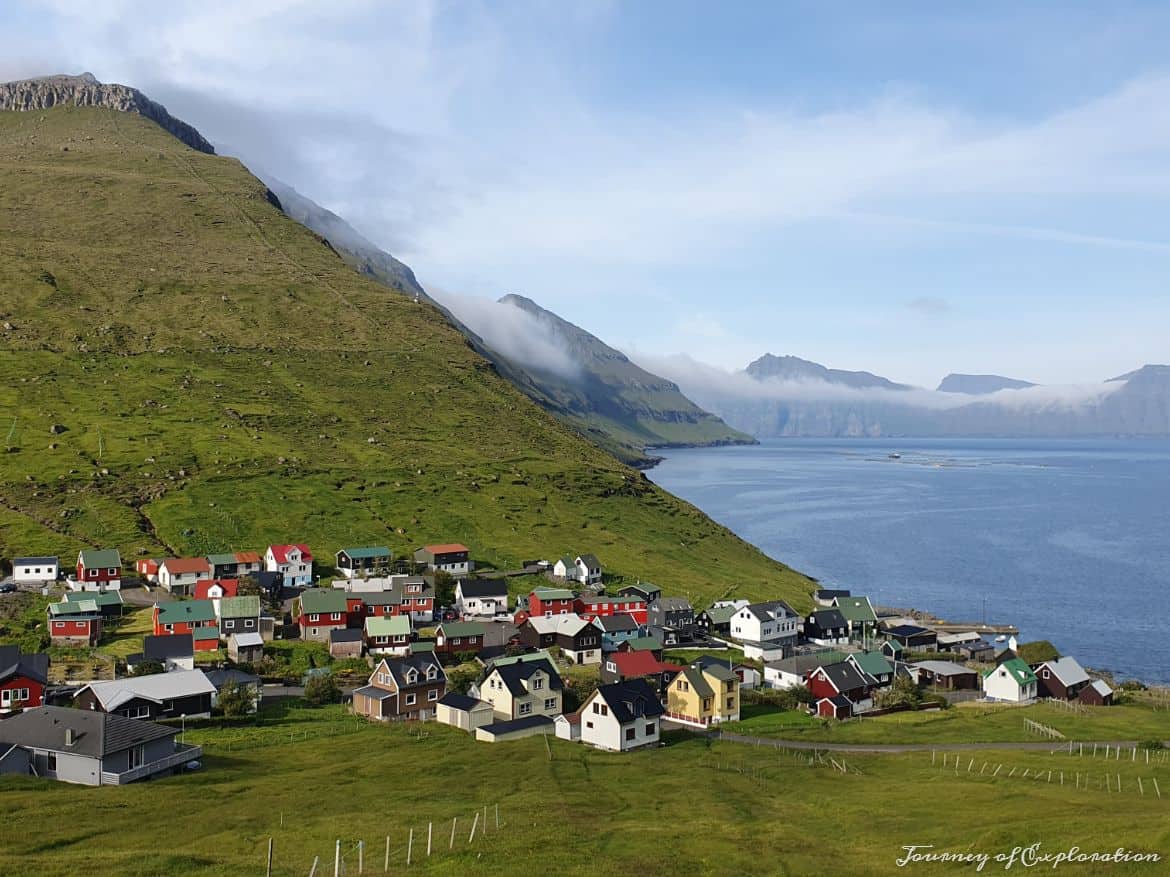
By Taxi
Taxis are available in Torshavn and larger villages and can be booked in advance, but they are considerably expensive.
You can use the following taxi service here.
By Bus
The public bus system connects major towns and some villages. It’s an alternative way to travel if you’re not renting a car, but the bus service can be limited and not very frequent so proper planning is required.
Bus services are provided by Strandfaraskip Landsins (SSL). Visit the SSL website for bus timetables and other transport information.
Tickets can be purchased from the bus driver or through their mobile app, depending on the operator.
By Ferry
Inter-island ferries operate between several islands, especially to and from smaller islands that are not connected by bridges or tunnels.
The services are fast and frequent, and you can travel to all of them as a foot passenger or with your own vehicle.
The ferries are usually small and during high season it is advisable to book in advance, especially if you are visiting the island of Kalsoy with a car.
For all the latest inter-island ferry timetables and booking information visit the SSL website.
Ferry Routes
- 7 Tvøroyri – Tórshavn
- 36 Sørvágur – Mykines
- 56 Klaksvík – Syðradalur
- 58 Hvannasund – Hattarvík
- 61 Gamlarætt – Hestur
- 66 Sandur – Skúvoy
- 90 Tórshavn – Nólsoy
By Helicopter
There is also an inter-island helicopter service operated by Atlantic Airways that is subsidized by the Faroese government. The aim is to give residents of the smaller islands a regular connection to the mainland, but it can be used also by tourists if seats are available; however, tourists can only travel one way and return with a different mode of transport.
Helicopter tickets can be booked and paid online. You can find the booking site by clicking HERE.
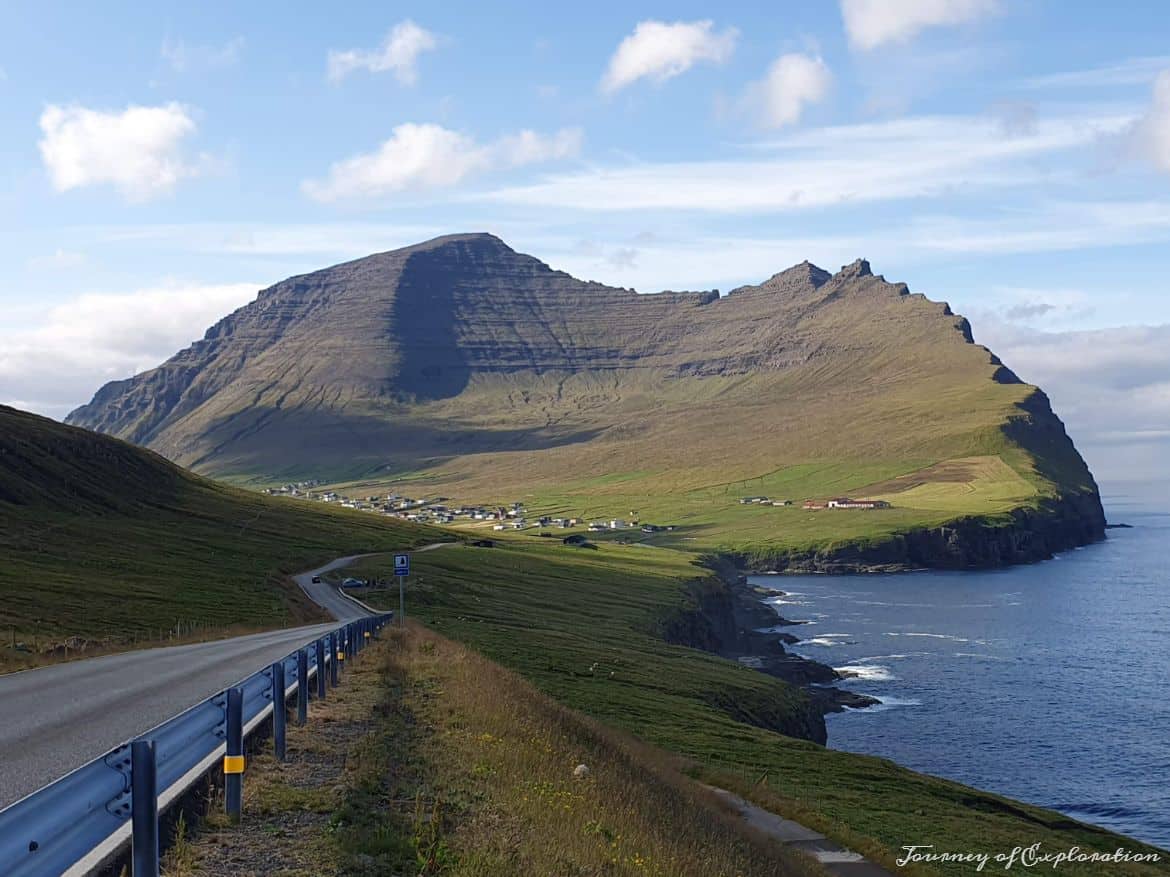
WHAT TO EAT & DRINK IN FAROE ISLANDS
The restaurants in the Faroe Islands are very limited outside the capital, Torshavn. Be aware that most restaurants stop serving food quite early in the evening (8pm).
Torshavn is the best place to go for a meal, as it has the most choices. Klaksvik is your second best bet with a few options for food. The rest of the villages have a very limited number of eateries and restaurants.
If you are on the road and it’s late, it’s worth considering one of the petrol stations that usually serve hot food.
It is also worth trying the various bakeries to enjoy some local pastries.
Below you can find a list of some of the best restaurants in the Faroes
Best restaurants in the Faroe Islands
- Katrina Christiansen (Toshavn)
- Barbara Fish House (Toshavn)
- ROKS (Toshavn)
- Ãarstova (Toshavn)
- Ræst (Toshavn)
- Húsagarður (Toshavn)
- THE TARV Grillhouse (Toshavn)
- Fiskastykkið (Sandavágur)
- Resturant Cafe Pollastova (Sørvágur)
- Angus Steakhouse (Klaksvik)
- Fish & Chips (Klaksvik)
You can check the location of these restaurants on this map.
Local Cuisine
- Pylsur (Faroese Hot Dog): A local favourite, often served with mustard, ketchup, remoulade, and crispy onions.
- Faroese Lamb: Known for its rich flavour, often prepared in traditional dishes like roasted lamb or lamb stew (bólt).
- Kjøttkaka (Meat Cake): A traditional Faroese meatloaf, typically made with beef or lamb and served with potatoes and vegetables.
- Ræst Kjøt (Cured Meat): Lamb or fish that has been air-dried and cured. It is often served thinly sliced.
- Faroese Fish: Fresh fish is a staple, with options including cod, haddock, and salmon. Traditional dishes include fish stew and fried fish.
- Skerpikjøt (Air-Dried Mutton): Mutton that is hung to air-dry and traditionally consumed with potatoes or as part of a meal.
- Plátur (Flatbread): Traditional Faroese flatbread, often served with cheese, cured meats, or fish.
- Faroese Cheese: Made from local dairy, including varieties like Faroese blue cheese and mild cheeses.
- Seaweed: Used in various dishes and often sought locally, adding a unique taste to soups, salads, and other meals.
- Whale Meat: Controversial but traditional, whale meat (such as pilot whale) is part of the local cuisine. It’s usually prepared in traditional dishes or as steaks.
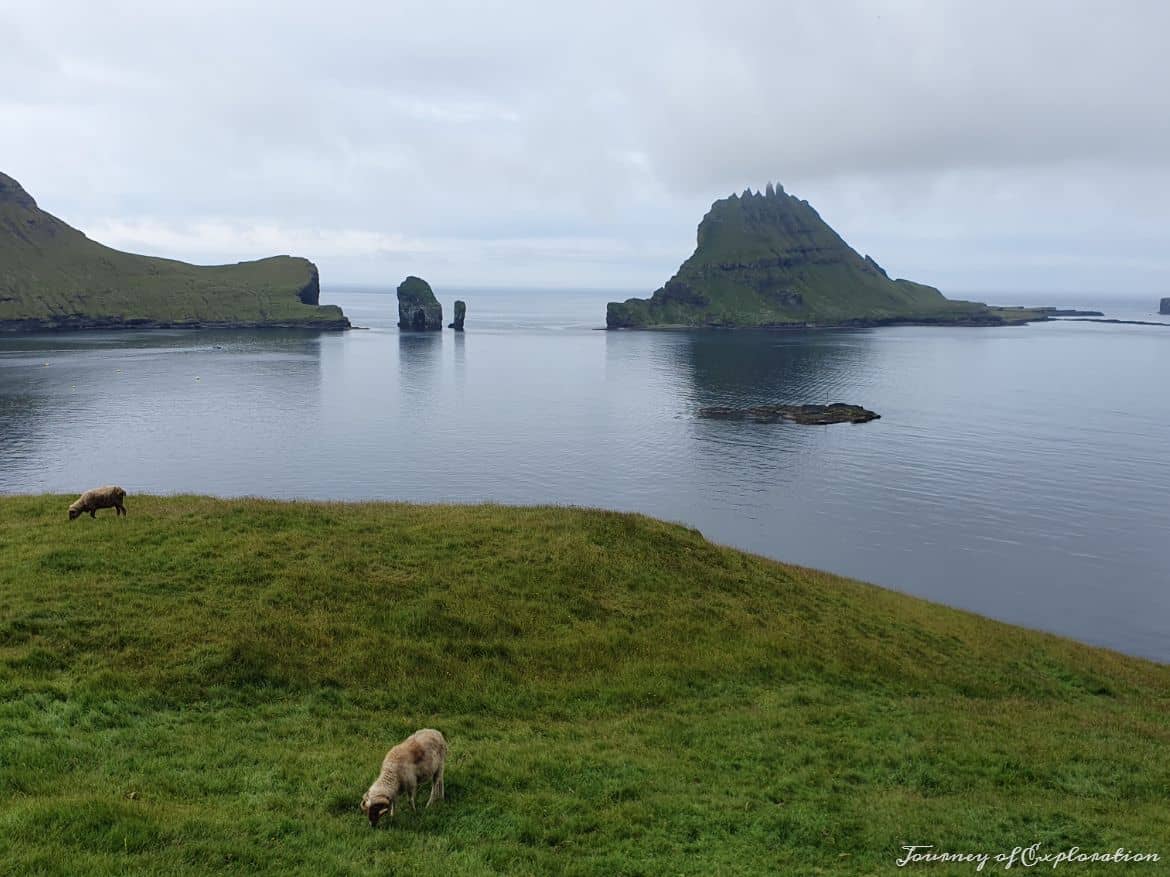
THINGS TO DO IN FAROE ISLANDS
Best sights & places to visit
1. Enjoy one of the scenic drives
Renting a car to explore the Faroe Islands at your own pace is one of the best things to do. It gives you the freedom to explore more remote areas and stop wherever you like to appreciate the views and take photos. Any route in the Faroe Islands is a scenic one, but some of the best routes that offer great views of the beautiful landscape and coastline are the following:
- Eysturoy Island: Explore the scenic routes around Eysturoy, including views of coastal villages (Funningur, Eidi, Elduvík, & Oyndarfjørður), Risin og Kellingin and the highest peak of Slættaratindur.
- Viðoy and Kalsoy Islands: Rugged cliffs and remote beauty with striking landscapes.
- Streymoy Island: The route (via 50) from Torshavn to Vestmanna is one of the most scenic ones on the island.
- Vágar Island: The route from Sorvagur to Gasadalur is one of the most scenic, with beautiful views of the Mulafossur Waterfall, Bøur Village and Drangarnir sea stacks.
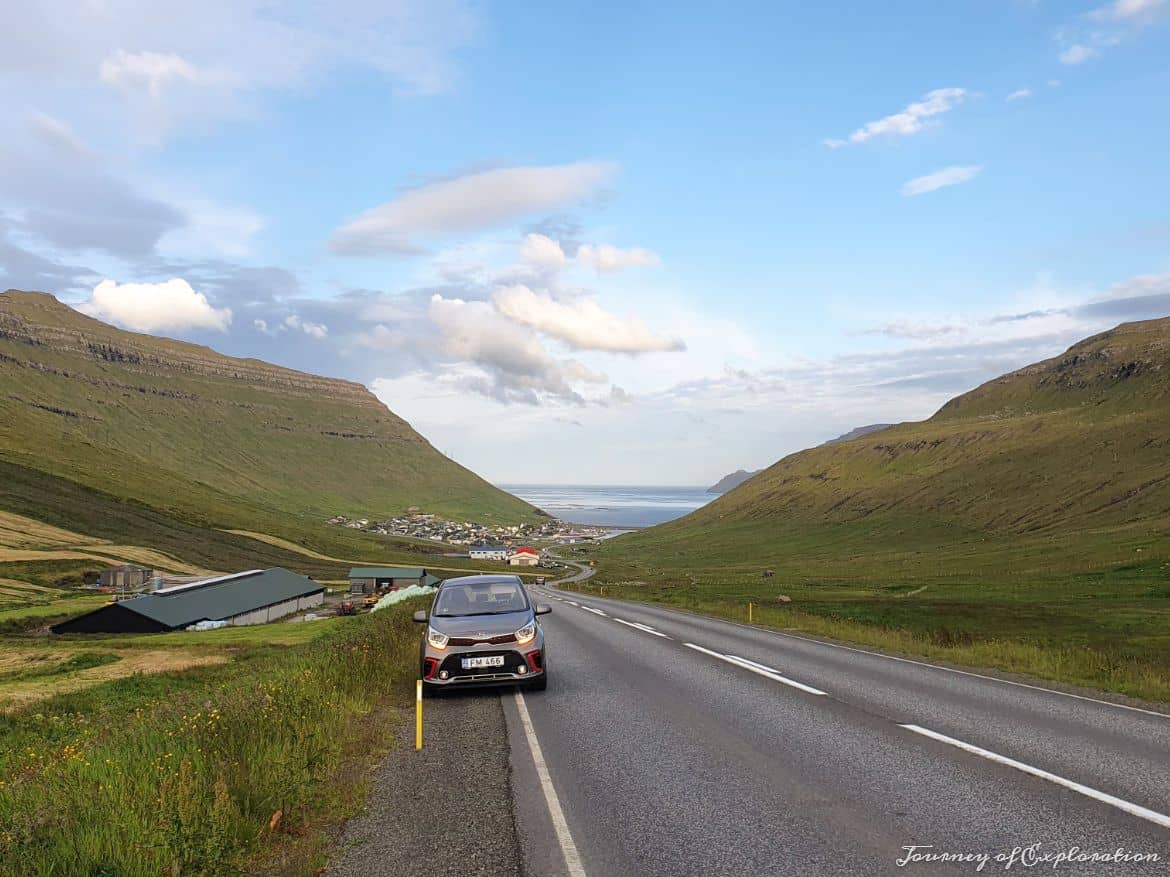
2. Explore the capital Tórshavn
Tórshavn is the capital and biggest town in the Faroe Islands. It is a charming coastal town with the most tourist amenities, accommodation and restaurants. Some of the best things to do in Tórshavn include:
- Tinganes: This is the old town with narrow lanes and colourful wooden houses with traditional grass-roofs. It is a pleasure to wander and provides nice views of the harbour. It is also the historic government district and the seat of the Faroese government.
- Tórshavn Cathedral: Visit the city’s historic church, which dates back to 1788.
- Faroe Islands National Museum: Learn about the history, culture, and art of the Faroe Islands.
- Waterfront: Walk along the waterfront and enjoy the views of the old town.
- Skansin: A 16th-century fortress offering nice views of the city and harbour.
- The National Gallery of The Faroe Islands: Beautiful museum with a permanent collection of Faroese art from the 1800s as well as temporary exhibitions. Very nice cafe and gift shop.
- Nordic House: A cultural hub hosting concerts, exhibitions, and events.
- Aquarium: A small aquarium, worth visiting if you have kids on a rainy day.
- H. N. Jacobsens Bókahandil: Visit this bookshop with an adjoining cafe, located in an old building, for some souvenir shopping.
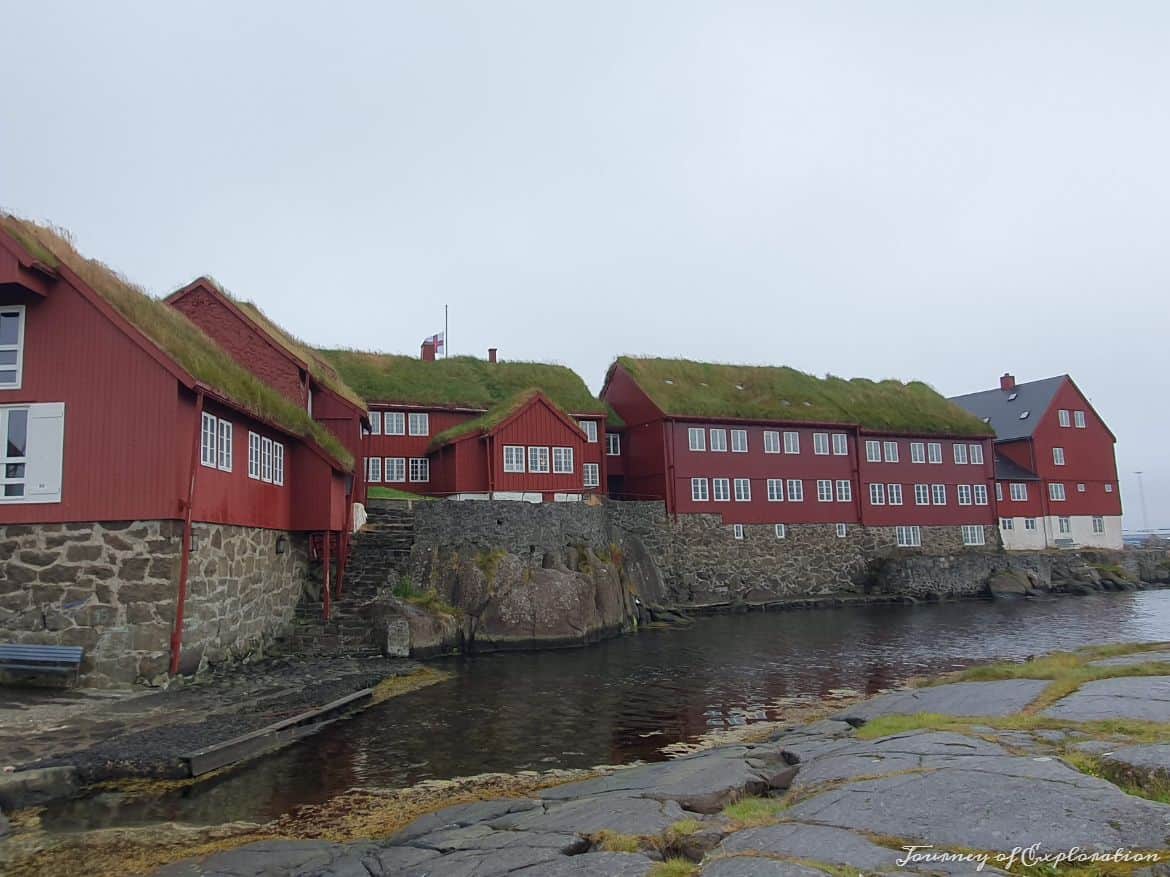
3. Hike to Trælanípa and Bøsdalafossur waterfall
This is one of the best hikes to do in the Faroes. It takes about 2 hours round trip and it is an easy hike, and mostly flat for most of its length.
Trælanípan (Slave Cliff) is a dramatic cliff that drops almost vertically into the Atlantic Ocean, providing panoramic views of the surrounding cliffs and coastline.
The hike also leads to Lake Sørvágsvatn (Leitisvatn), the largest lake in the Faroe Islands, which creates the famous optical illusion of floating above the ocean.
You can also visit Bøsdalafossur Waterfall, a stunning waterfall where the lake empties into the ocean.
Hike Details:
- Difficulty: Easy to moderate
- Distance: Approximately 7 km (round trip).
- Duration: 2-3 hours, depending on your pace.
- Start Point: The trail begins near Miðvágur village on the island of Vágar. There’s a parking area with signs pointing to the trailhead.
- Fee: There is a fee (200 DKK) to access the trail payable at the entrance near the car park.
- Weather: Choose a clear day because the cliffs can often be misty and it is not worth it if you cannot see the views. Path can be muddy at places.
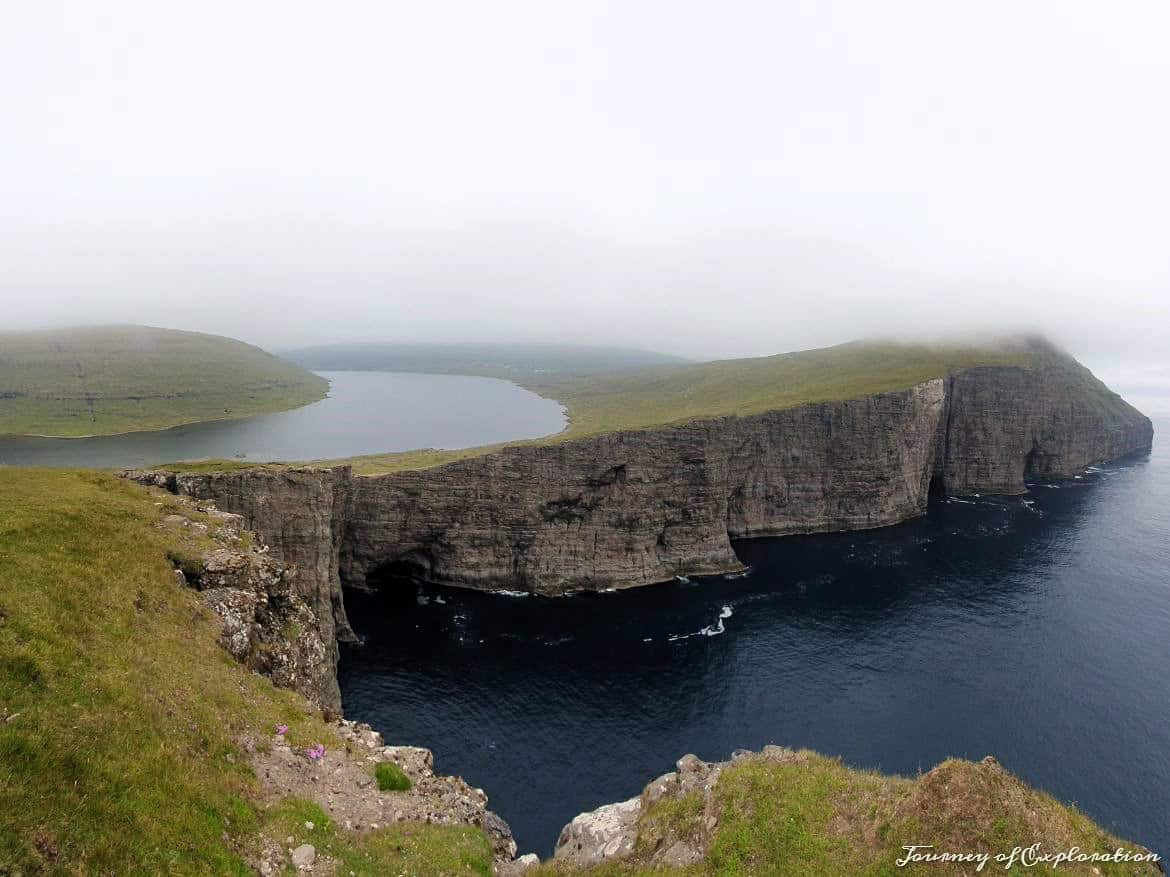
4. Mulafossur Waterfall
Múlafossur Waterfall is one of the most iconic and picturesque locations in the Faroe Islands. This breathtaking waterfall is located near Gásadalur village within dramatic surroundings. The waterfall cascades directly into the ocean from a height of about 30 meters, with the scenic backdrop of the quaint village and rugged cliffs.
There is a car park and a small path towards the main viewing spot, just a short walk from the parking area. It can get very busy with coaches and tourists during the high season.
It is worth exploring Gásadalur and some of the hiking trails nearby that provide good views of the cliffs and ocean.
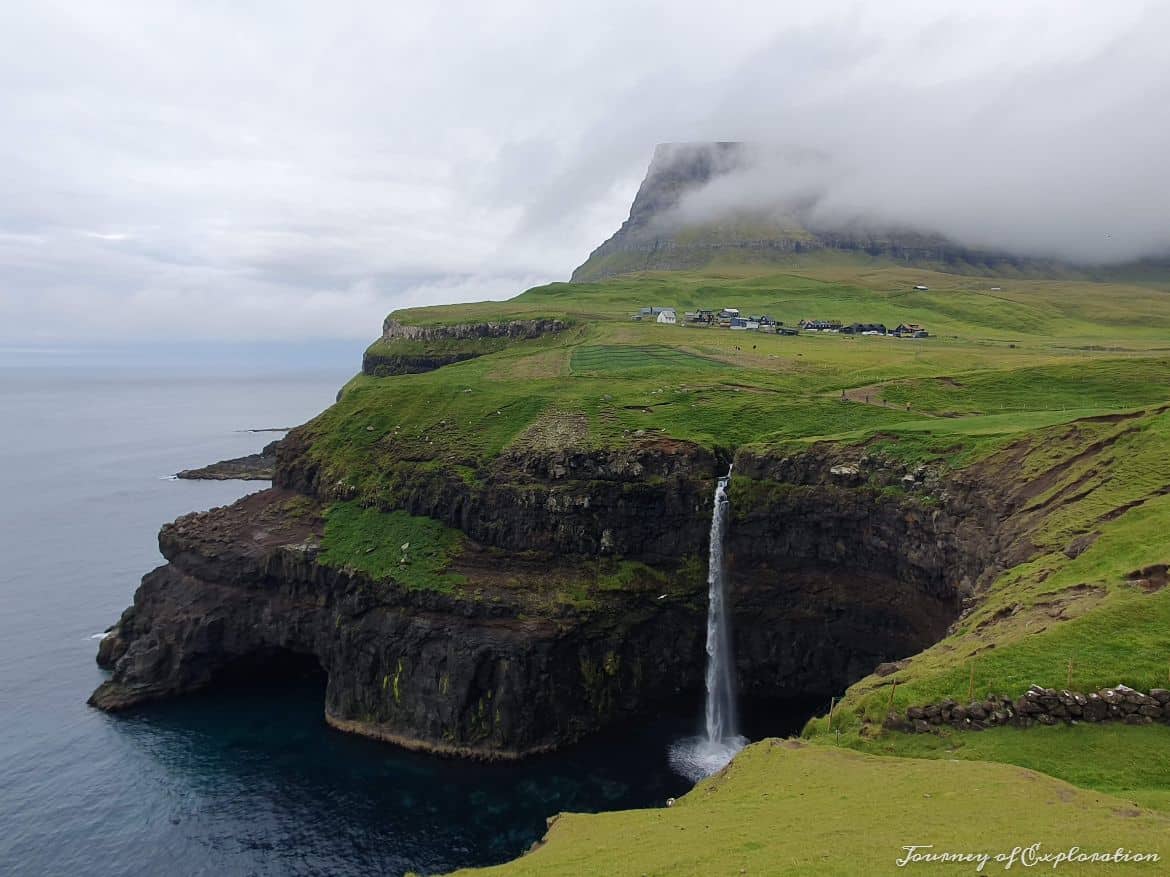
5. Saksun lagoon
The Saksun Lagoon is a stunning place worth exploring, located on the island of Streymoy. Saksun is about a 1-hour scenic drive from Tórshavn
Saksun’s picturesque village is set in a natural amphitheatre, surrounded by cliffs. You can stop at the car park and enjoy the breathtaking views towards the lagoon. The village has some traditional turf-roofed houses and a small church. There is also a restored 17th-century farmhouse turned museum that offers insight into traditional Faroese life. For the best views and photo spots, you might need to pay a fee to access them.
During low tide, you can hike down to the scenic lagoon with the black sandy beach that leads out to the Atlantic Ocean.
There are other hiking trails in the area, including routes to nearby waterfalls, offering spectacular views of the mountains.
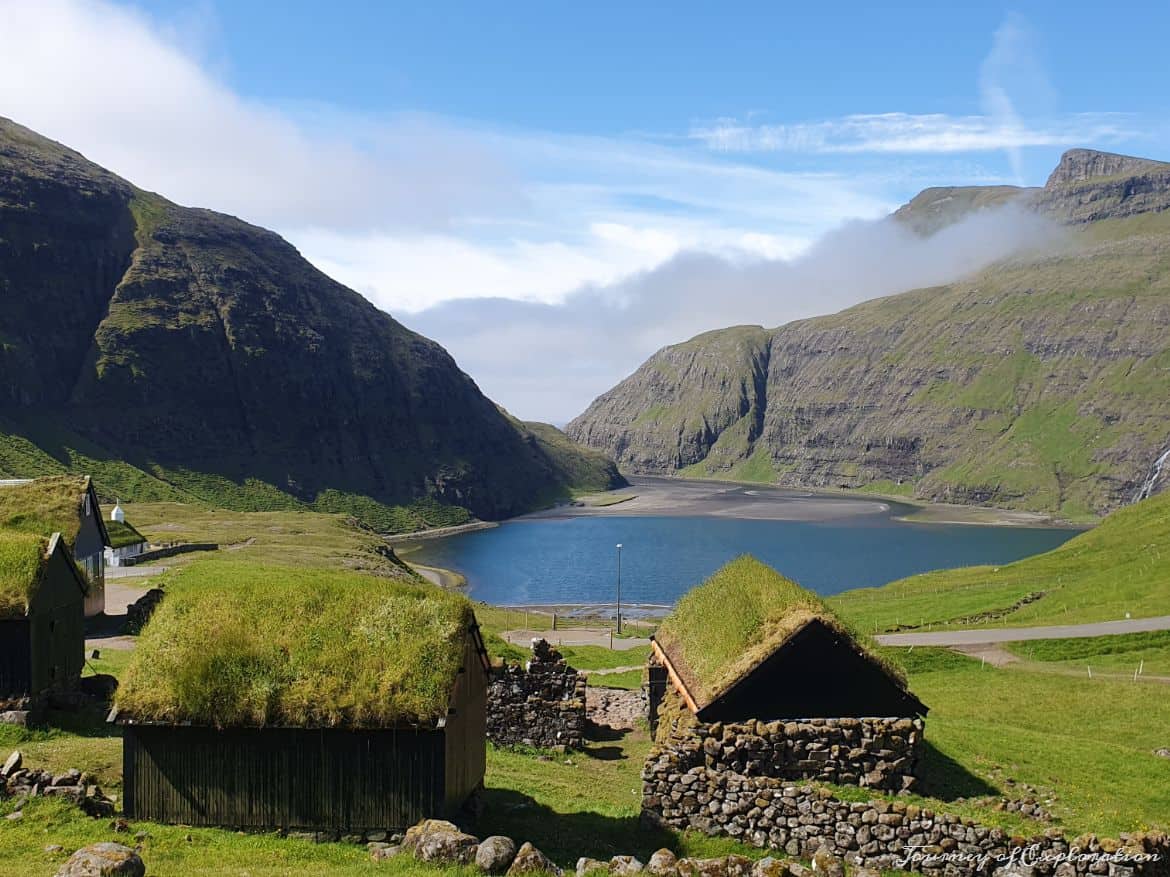
6. Boat trip to Mykines Island
Mykines Island is a great destination to visit, famous for its seabird colonies, as well as breathtaking cliffs and views of the Atlantic Ocean. It is the best place to see puffins up close, but you can also see gannets, fulmars, and razorbills. The best time to visit for puffins is during the summer months (from May to August).
Mykines is sparsely populated, with only a handful of permanent residents. You can wander through the quaint village with its turf-roofed houses and enjoy the peaceful atmosphere.
Nowadays you need to book a guided tour to visit the puffin colonies on their nesting cliffs and access some of the hiking trails. You can do this online before you arrive or upon arrival. You won’t be allowed to go further from the village if you don’t pay the fee for the guided tour.
The popular hike to the Mykineshólmur Lighthouse, located on a small islet connected to Mykines by a narrow footbridge has remained closed since the destruction of the footbridge.
You can get to Mykines Island by boat departing from Sørvágur on the island of Vágar. The trip takes about 45 minutes, but schedules depend on weather conditions. That is the cheapest way of getting to the island but it’s highly recommended to book in advance. From the boat you can enjoy the scenic views of Tindhólmur Island and Drangarnir Rocks. It is worth wearing warm layers for the trip, as it can be cold and windy on the boat.
A helicopter service is also available from Vágar Airport. It’s a quick and scenic way to reach the island, though seats are limited and it is more expensive.
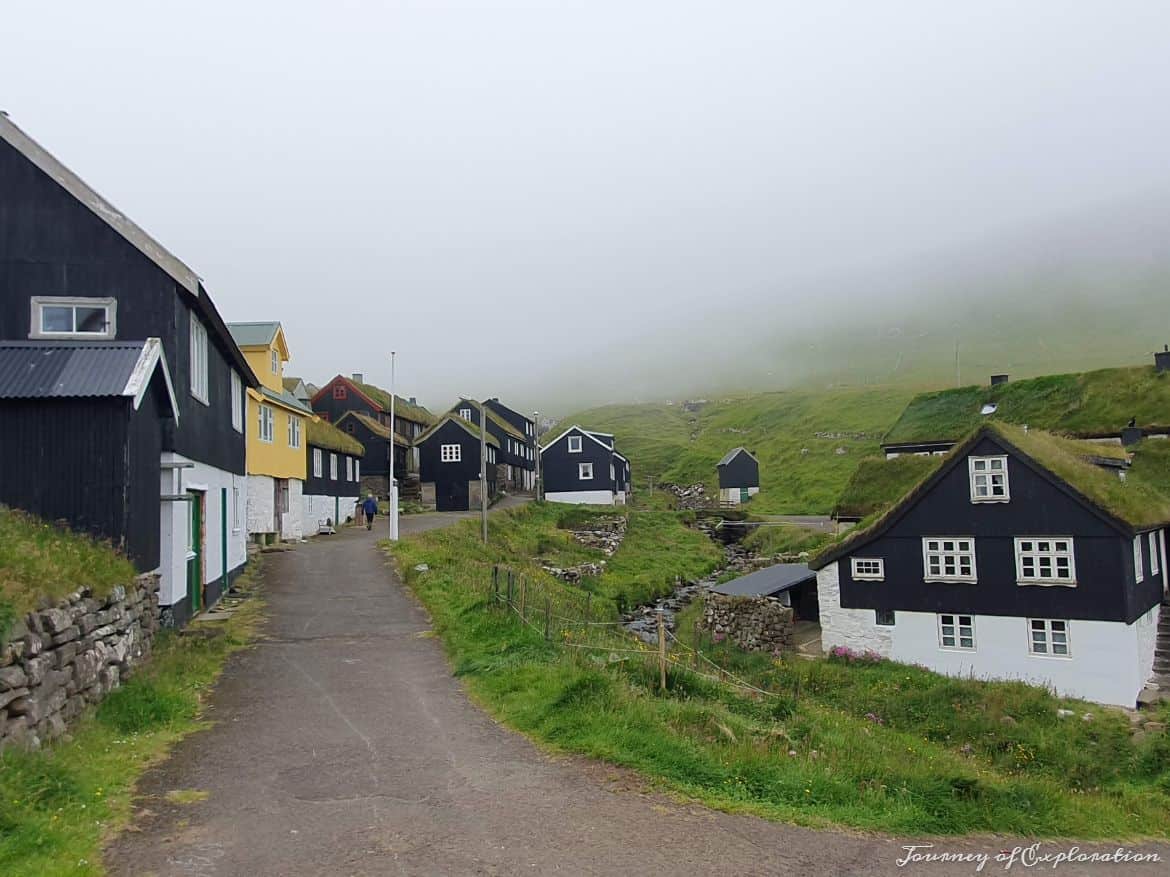
7. Visit Kalsoy Island and hike to Kallur lighthouse
Kalsoy is a spectacular destination, a remote island, famous for its dramatic cliffs and lighthouse. It is part of the northern islands of the Faroes, with a long, narrow shape and multiple tunnels.
It is only accessible by ferry from Klaksvik. The ferry operates between Klaksvík and the village of Syðradalur on Kalsoy. The journey takes about 20 minutes. Ferry schedules can vary, and spaces for vehicles are limited, so taking a car can be tricky as you need to book in advance. It’s better to leave your car in Klaksvik and use the connected bus when you arrive that goes all the way to Trøllanes. The bus is not very frequent so you need to check the timetable for your return trip and be prepared to wait. If you take a car, you need to be careful when driving through Kalsoy’s network of narrow, single-lane tunnels. The drive between the tunnels offers some amazing views.
One of the best things to do in Kalsoy is to hike to the Kallur lighthouse and enjoy the views of the cliffs and surrounding islands. This is the most popular activity on Kalsoy. The trail begins in the village of Trøllanes and takes about 1.5 hours round trip. The lighthouse is one of the most photographed spots in the Faroes.
You can also visit the small, picturesque village of Mikladalur with its traditional Faroese houses and stunning views. Mikladalur is home to the famous Seal Woman Statue, a bronze sculpture inspired by the Faroese legend of the selkie. It’s perched dramatically on a rock overlooking the ocean.
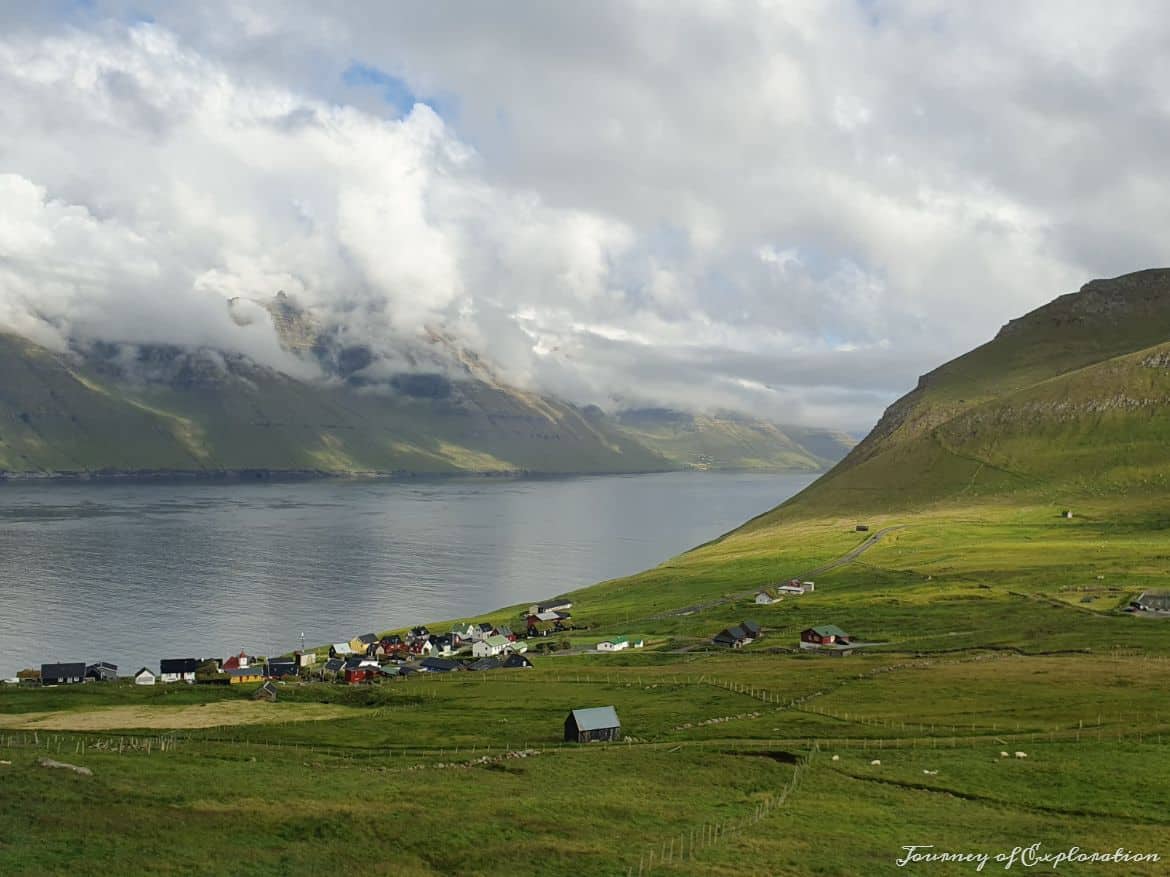
8. Explore the villages of Gjógv, Funningur and Tjørnuvík
These three villages are the most beautiful and picturesque in the Faroe Islands, situated in a stunning setting.
The view of Funningur from the road above is one of the most stunning vistas in the Faroes.
The drive to the seaside village of Tjørnuvík provides some great views towards the village and the sandy beach set among dramatic cliffs.
Gjogv is a beautiful village to explore with sea cliffs near the harbour where you can spot puffins and other sea birds. It’s worth taking the hike from the village up to the cliffs on the other side to see the puffins up close. This hike is free and provides good views towards the village.
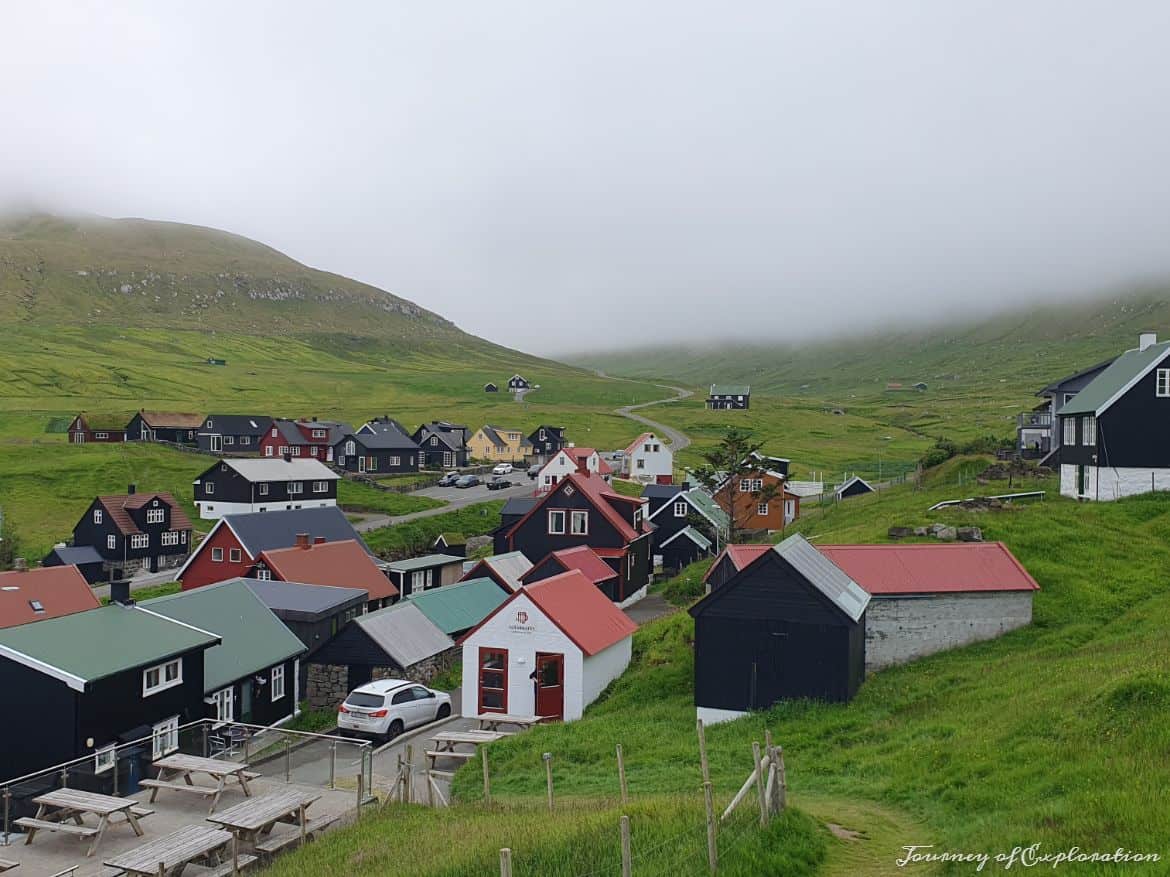
9. Boat tour of Vestmanna Cliffs
The Vestmanna Cliffs are one of the most famous natural attractions in the Faroe Islands and are home to numerous seabird species, including puffins, guillemots, and fulmars.
The cliffs are best explored by boat, allowing you to pass through narrow sea inlets and caves. You can take a boat tour to see the impressive sea cliffs and seabirds up close. Tours typically last around 1.5–2 hours and start from Vestmanna Harbour. It might be worth booking it in advance in high season.
You can also explore this quaint fishing village with its charming harbour and traditional Faroese atmosphere. The area around Vestmanna village also has several scenic walks through valleys and hills.
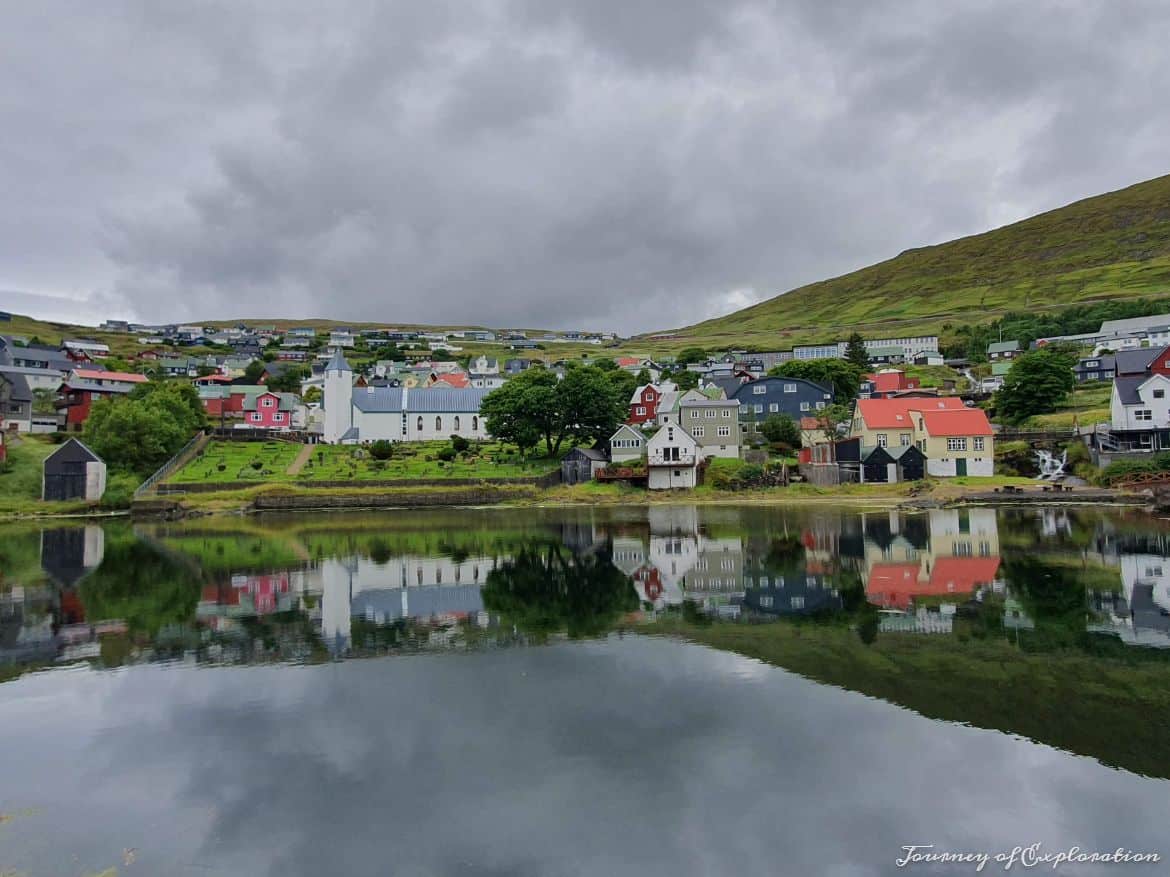
10. Visit the village of Kirkjubøur
Kirkjubøur is a historical coastal village with medieval ruins, an old church and wooden farmhouses. It’s a significant cultural and historical site in the Faroe Islands.
You can visit the Kirkjubømúrurin, the ruins of the medieval Cathedral of St. Magnus. It is believed to have been built in the 1300s and was once the largest church in the Faroes.
You can also explore the historic Church of St. Olav by the scenic harbour.
Kirkjubøur is located on the southern tip of the island of Streymoy, just a short drive from Tórshavn (about 25 minutes).
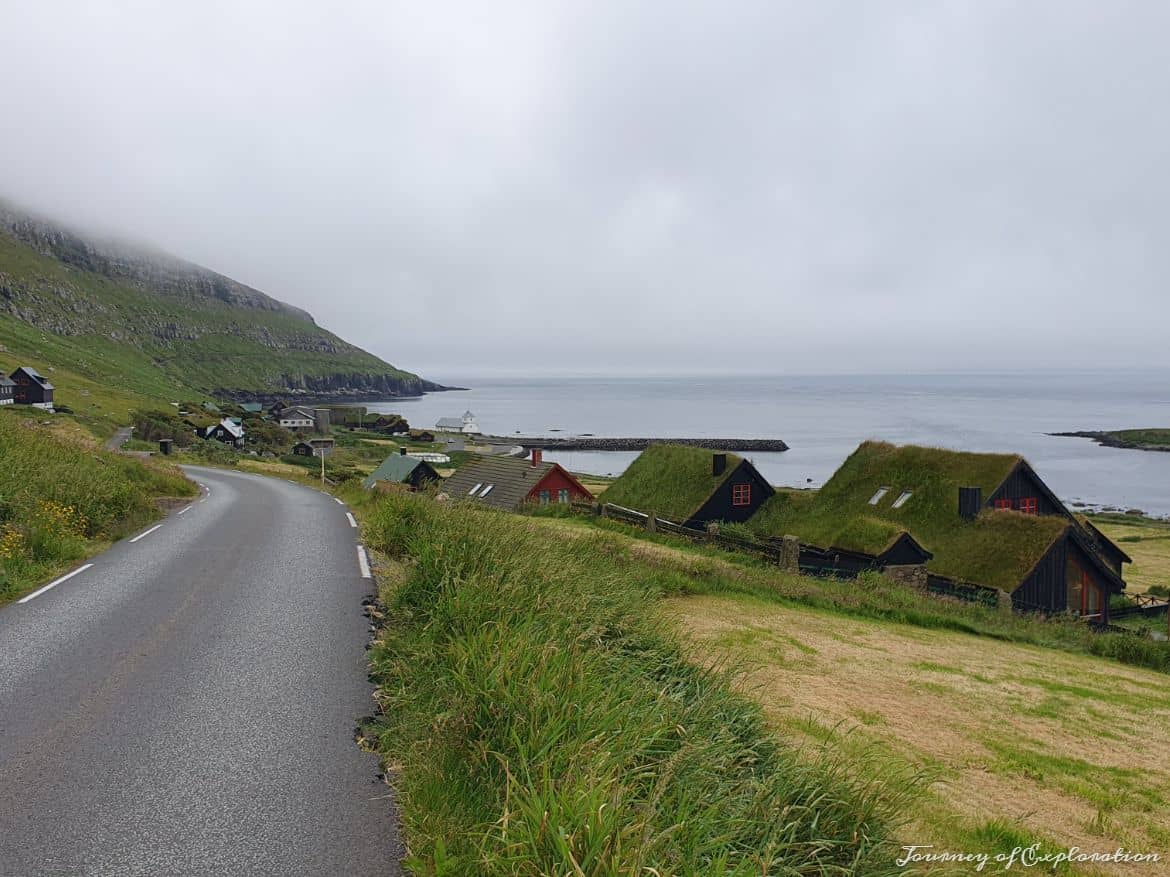
11. Hike Slættaratindur
Slættaratindur is the highest mountain in the Faroe Islands (standing at 882 meters), offering panoramic views of the surrounding islands and ocean on a clear day.
Slættaratindur is located on the island of Eysturoy, the second-largest island in the Faroe Islands.
It is one of the most popular hikes on the islands. The hike to the summit of Slættaratindur is challenging but rewarding. The trail is about 6 km (3.7 miles) round-trip and takes approximately 3-4 hours to complete. There is a small car park at the bottom of the mountain where you can start the hike (located on the road between Eiði and Funningur.
12. Drive to the northern isles
The Northern Isles of the Faroe Islands, which include Kalsoy, Kunoy, Vidoy, Borðoy, and Svínoy, are a group of islands located northeast of the main islands. These islands are known for their rugged landscapes, traditional coastal villages, and dramatic cliffs.
The drive through the northern isles requires passing several tunnels and one-way systems but rewards with great viewpoints and scenic vistas along the way.
Kunoy Island: There is only a single road leading to the small but picturesque village set among dramatic cliffs. You can visit the local church and enjoy the views of the sea and Kalsoy Island.
Vidoy Island: Vidoy is one of the most picturesque islands with great scenery. The village of Vidareidi, located on the northern tip of the island, offers spectacular views of the surrounding fjords and mountains. It’s a quiet village and the start of a challenging hike to Villingardalsfjall–Enniberg. Hvannasund is another pretty coastal village among dramatic cliffs.
Borðoy Island: Borðoy is one of the more populated islands and includes the town of Klaksvík, the second-largest town in the Faroe Islands. It serves as a hub for the northern islands. It is connected with Eysturoy with a long underwater tunnel.
Klaksvík is located in a beautiful bay among dramatic cliffs and offers some modern amenities, great hiking opportunities and an interesting church (Christianskirkjan).
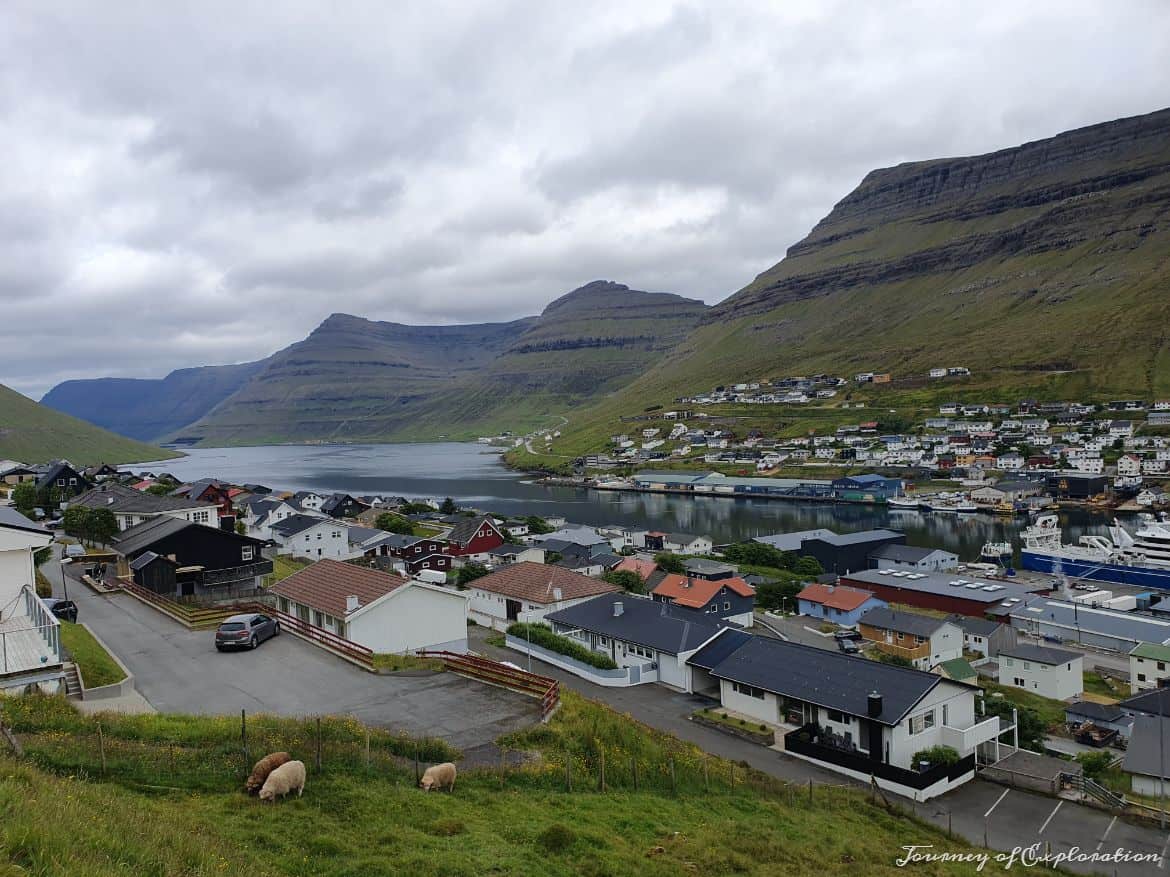
18. Sornfelli
Sornfelli is a mountain plateau on the island of Streymoy, about 12 km from the capital Tórshavn. It is the site of a former military station at 725m above sea level.
The summit of Sornfelli is a fantastic vantage point close to Thorshavn, where you enjoy panoramic views of the surrounding landscape and towards Vagar.
The easiest way to get to Sornfelli is by car over the mountain road “Oyggjarvegin“. The drive from Tórshavn takes about 20 minutes. The road to Sornfelli is paved but very narrow and winding in places.
It is often foggy and covered by clouds, so you must visit on a clear day.
19. Klakkur
The Klakkur hike is one of the most popular and rewarding hikes on Borðoy Island in the Faroe Islands. The mountain Klakkur, standing at 416 meters, offers incredible views over the town of Klaksvík, the surrounding fjords, and neighbouring islands.
It is an easy to moderate hike and the trail begins at the outskirts of Klaksvik. It is a well-maintained path that gradually ascends to the summit.
As you climb, you’ll have fantastic views over the town of Klaksvík and the surrounding area. The town sits at the head of a fjord, with dramatic cliffs and hills all around it. You can see the neighbouring islands of Borðoy, Kunoy, and Viðoy, and sometimes even Svínoy depending on the weather.
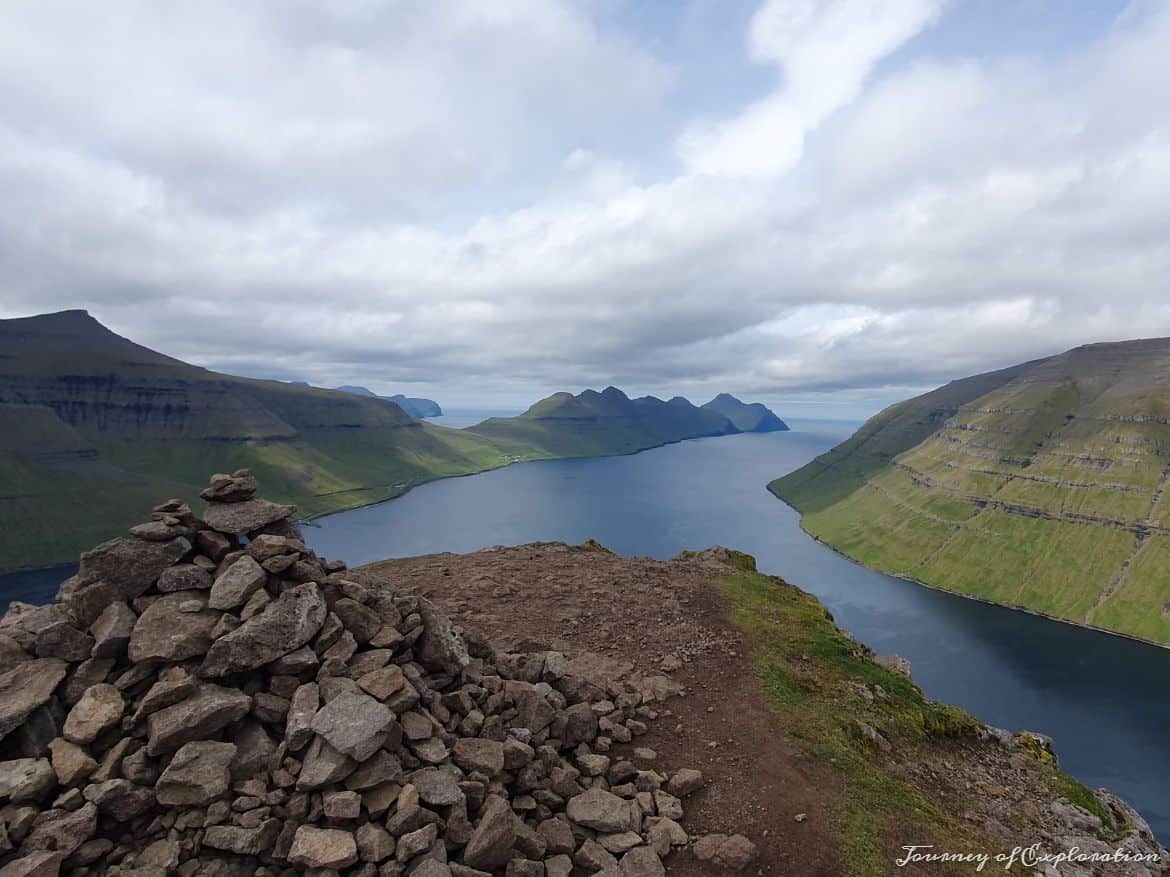
20. Sandoy Island
Sandoy Island is one of the less-visited islands in the Faroes, making it perfect for those seeking an even more tranquil experience. It has more gentle landscapes compared to the rest of the Faroes, with rolling hills and sandy beaches, but the landscape is still scenic and worth exploring.
It has one of the best beaches in the Faroe Islands in Sandur and some nice coastal villages, like Husavik, Dalur, Skalavik and Skopun. Sandur is the largest village on the island and its cultural centre, located next to a beautiful white sandy beach and a lake on the other side. You can visit the Sandur Art Museum and the local church. Húsavík has also a beautiful beach and some charming turf-roofed houses. Dalur is a small and picturesque village nestled in a valley and surrounded by mountains.
The island is connected with the new underwater tunnel to Streymoy and it is now possible to visit Sandoy on a day trip from Torshavn. Alternatively, you can take the ferry that connects the village of Gamlarætt (near Tórshavn) to Skopun on Sandoy via Hestur.
From Sandur, you can take a boat to visit the tiny island of Skúvoy.
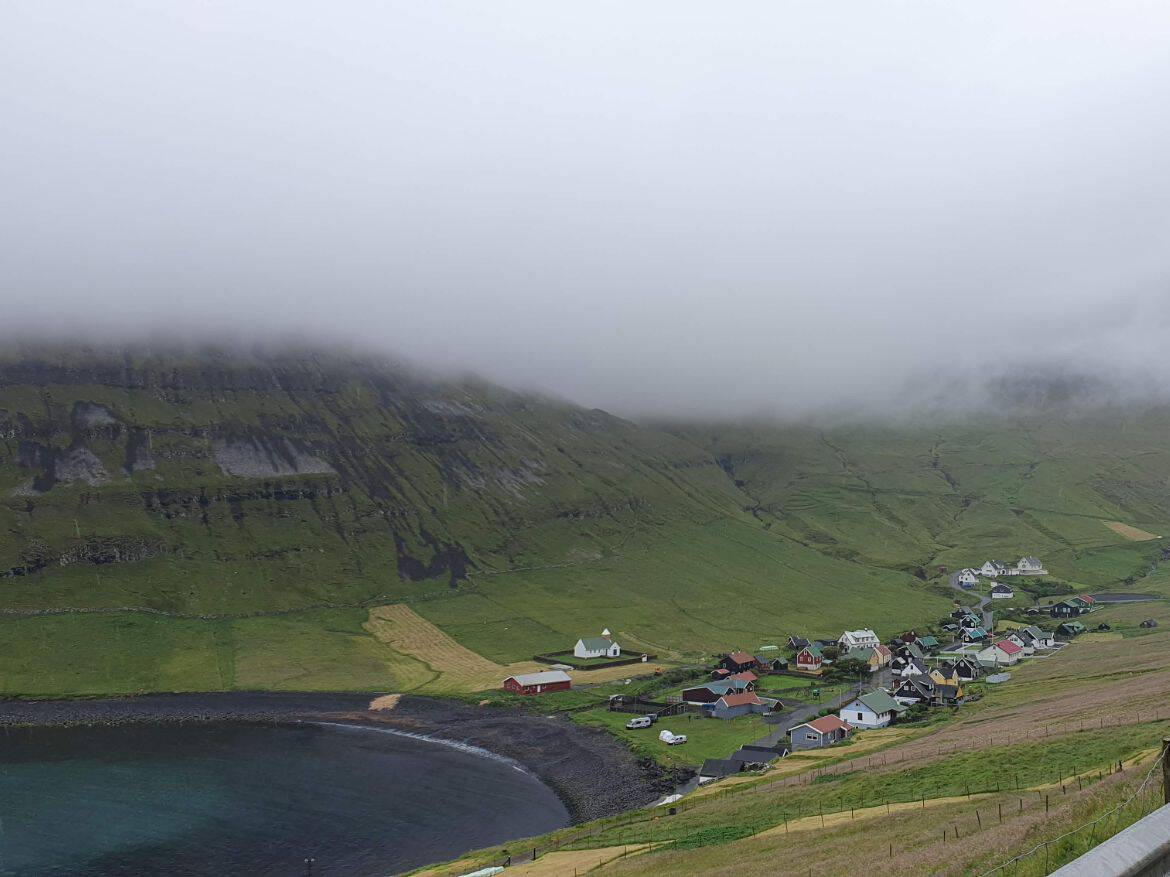
FAROE ISLANDS BEST TOWNS & VILLAGES
- Tórshavn: The capital and largest city of the Faroe Islands, with the most tourist amenities and a beautiful old town with wooden houses.
- Klaksvík: The second-largest town in the Faroe Islands, known for its fishing industry and scenic harbour.
- Funningur: A picturesque seaside village in a beautiful setting. The view from the top of the road is amazing.
- Gjógv: A beautiful village with a natural harbour and seabird cliffs.
- Tjørnuvík: A small village located on the island of Streymoy, with a scenic beach with views of the surrounding cliffs and the dramatic rock formations.
- Kirkjubøur: The oldest village in the Faroe Islands, known for its historical significance and well-preserved buildings.
- Kvívík: A scenic coastal village with waterfalls. The road to Vestmanna provides unique viewpoints of the village.
- Saksun: A village set in a natural amphitheatre providing great views of the scenic lagoon.
- Mikladalur: A village on the island of Kalsoy in a dramatic setting.
- Vestmanna: Vestmanna has a nice harbour for a walk.
- Gásadalur: A village located on Vágar Island, close to Mulafossur Waterfall in a beautiful dramatic setting.
- Fuglafjørður
- Bøur
- Elduvík
- Árnafjørður
- Oyndarfjørður
- Viðareiði
- Sandavágur
- Sørvágur
- Hvannasund
- Kunoy
- Eiði
- Skarvanes
- Norðradalur
- Húsavík: A charming coastal village on the island of Sandoy.
- Sandur: A village on the island of Sandoy close to a beautiful beach and a lake.
- Skálavík
- Dalur
- Haldarsvík
- Runavík: A town on the island of Eysturoy within a scenic fjord.
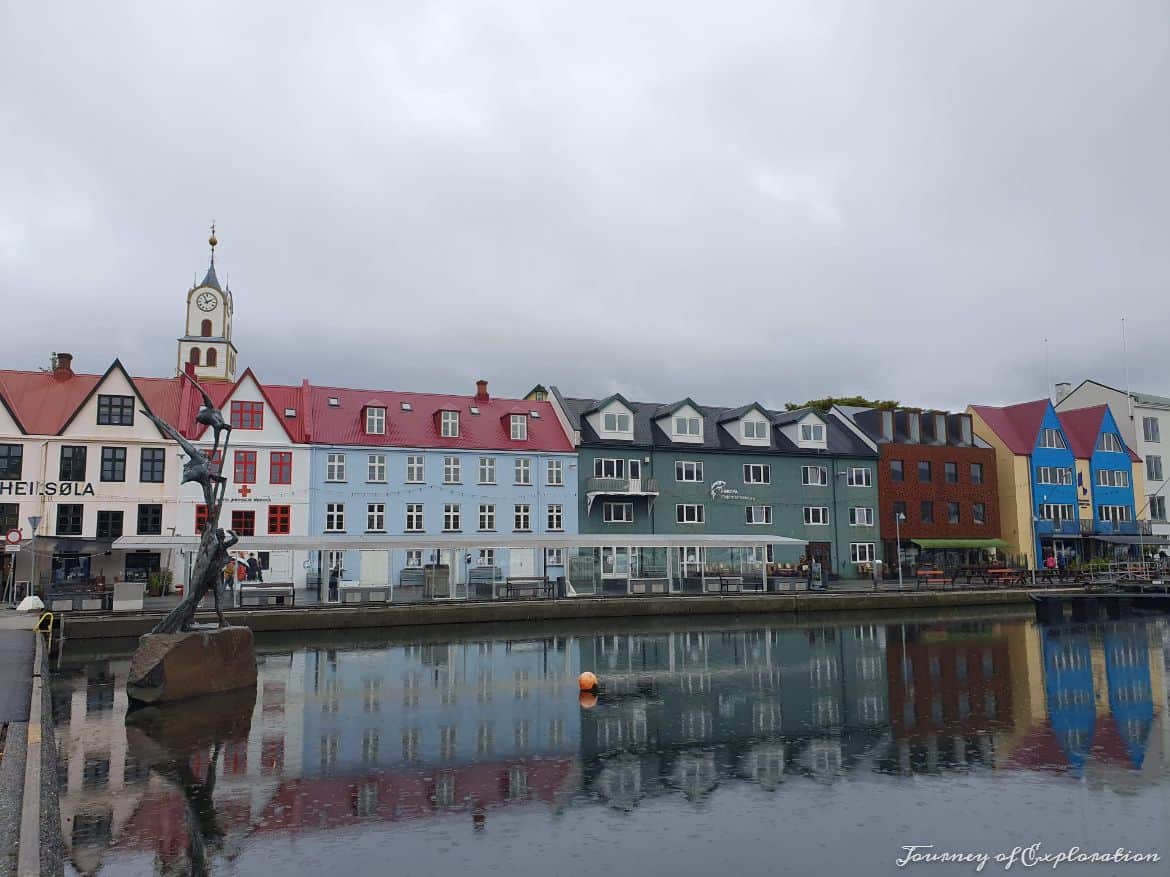
FAROE ISLANDS BEST BEACHES
The Faroe Islands, while known more for their dramatic cliffs and rugged landscapes, do have some nice beaches.
Here is a list of the best beaches to visit on the Faroe Islands:
- Saksun Beach: A stunning black sandy beach situated in a natural lagoon and surrounded by dramatic cliffs.
- Tjørnuvík Beach: A small, scenic beach in the village of Tjørnuvík with black sand and stunning views of the Risin og Kellingin rock formations.
- Sandur Beach (Sandoy Island): Located on the island of Sandoy, this is a beautiful sandy beach, one of the few with white sand compared to the black sand found elsewhere.
- Leynasandur Beach: A lovely little sandy beach on the Island Streymoy, on the way to/from Vestmanna
- Sandagerð Beach: A small sandy beach bear Torshavn
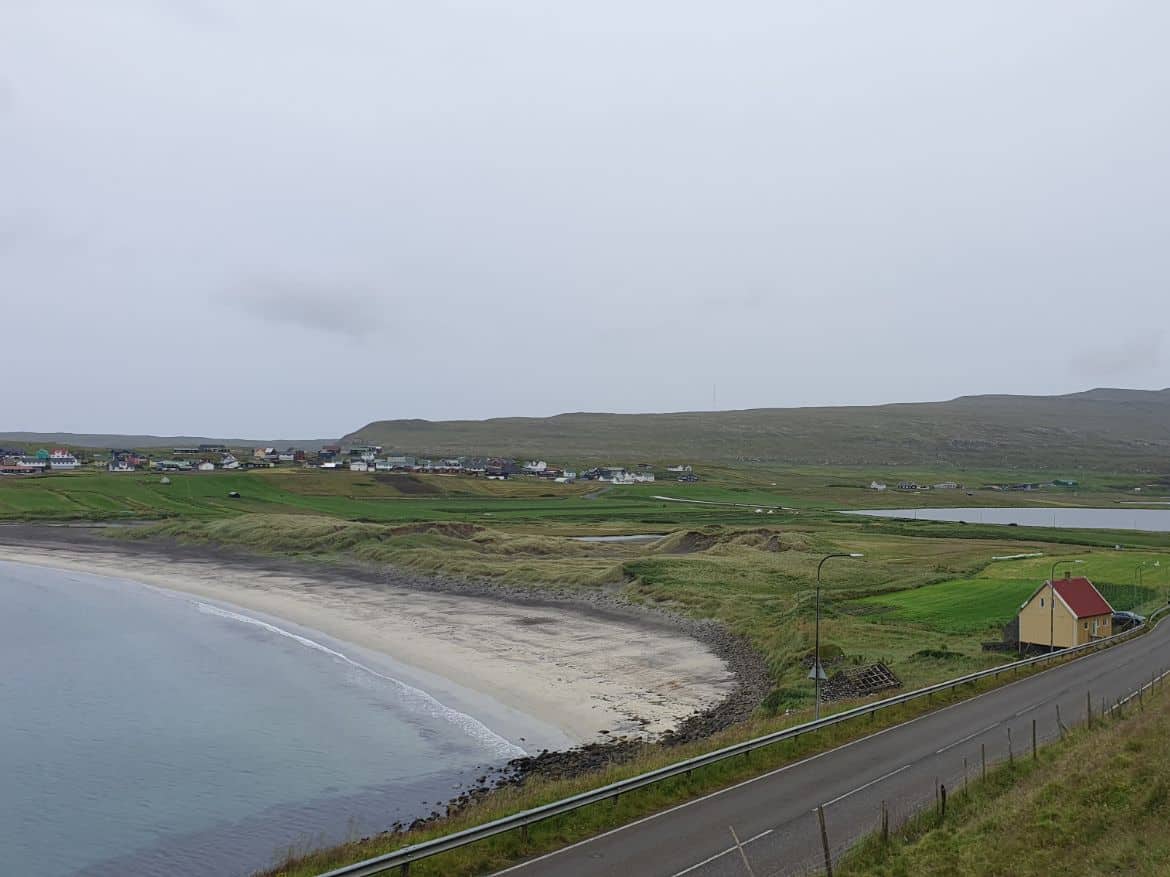
FAROE ISLANDS TOURIST MAP
You can click on the map below for the location of the best places to visit, the best restaurants & hotels, as well as the best viewpoints and photo spots.
To save the map, make sure you are logged in to your Google account, then click on the star to the right of the title. To locate the map go to your Google Maps app (or Account), click on ‘Saved’ (or ‘Your Places’), and select ‘Maps’.
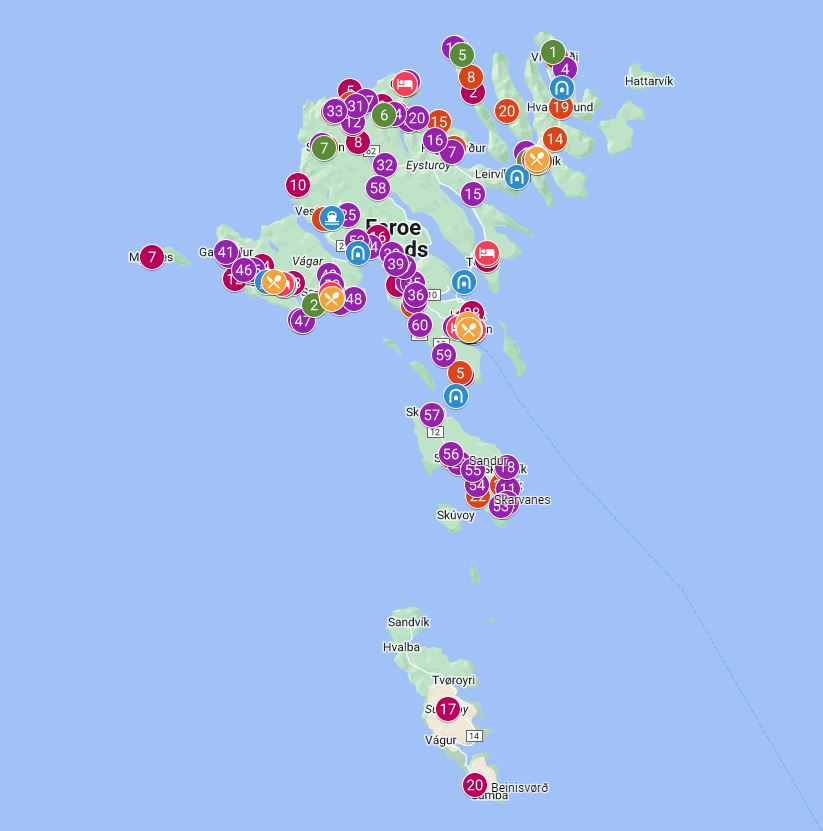
FAROE ISLANDS ITINERARY
It is worth staying in the Faroe Islands for a full week if you want to explore them. The following itinerary includes things to do for 7-9 days on the islands. I have taken Torshavn as a base & overnight stay for the duration of the trip, but it might be worth staying in Vagar Island and Klakskvik also to minimise driving time and tunnel costs.
Day 1: Vagar Island
- Morning arrival at the airport. Collect your rental car.
- Explore Gásadalur village: walk to Mulafossur Waterfall and enjoy the picturesque surroundings.
- Vist the village of Sandavágur and see theTrøllkonufingur Viewpoint.
- Drive to Torshavn to your accommodation.
- TIP: It might be worth staying in Vagar Island for the first night.
Day 2: Vagar & Mykines Island
- Morning hike of Lake Sørvágsvatn to Trælanípa.
- Afternoon ferry to the island of Mykines
- Guided tour of the puffins.
- Return to Torshavn to your accommodation.
Day 3: Tórshavn & Vestmanna
- Drive to Vestmanna for a sea cliffs tour.
- Stop at the scenic village of Kvívík.
- Explore Tórshavn: visit the Old Town (Áarvegur), Tinganes, and the National Museum of the Faroe Islands.
- Enjoy the harbour area and stroll along the waterfront.
- Enjoy dinner at a restaurant in Tórshavn.
Day 4: Streymoy & Eysturoy
- Visit the Saksun lagoon, with an optional walk to the beach.
- Visit Tjørnuvík village to enjoy the views from its beautiful beach.
- See the Fossá Waterfall
- Enjoy the scenic drive around Eysturoy
- Photo stops at various viewpoints (Eidi, Risin og Kellingin, Funningur)
- Visit the village of Gjogv to see the puffins.
- Continue to Elduvik and Oyndarfjørður
- Return to Toshvan.
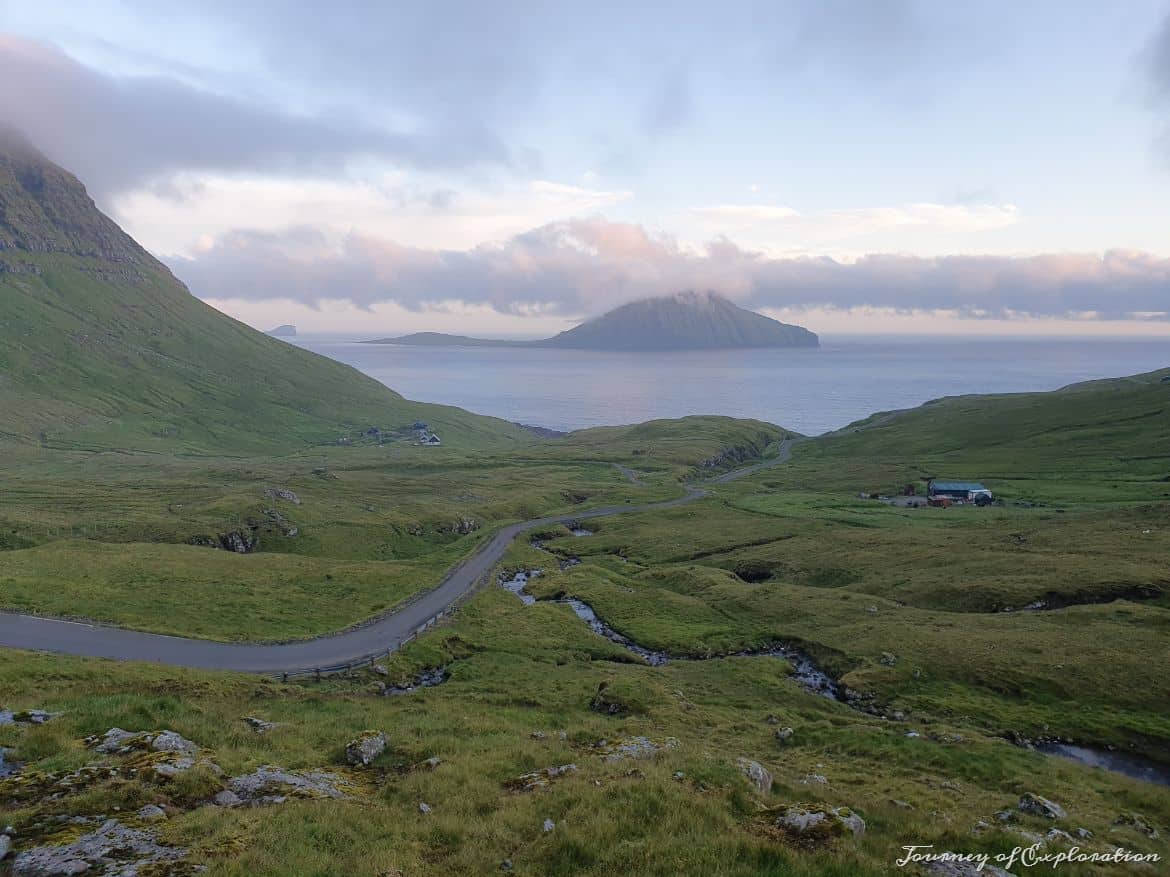
Day 5: Kalsoy & Klaksvik
- Early drive to Klaskvik.
- Take the ferry to Kalsoy.
- Take the bus to Trollanes.
- Hike to the Kallur Lighthouse.
- Return to Klaksvik and explore the town.
- Back to Torshavn through the Eysturoyartunnilin.
- TIP: It might be worth staying for one night in Klaksvik.
Day 6: North Isles Tour
- Drive to Klaksvik
- Hike to Klakkur to enjoy magnificent views of the town and surrounding islands.
- Enjoy the scenic drive to the islands of Kunoy and Vidoy.
- Visit the nice villages of Viðareiði and Hvannasund
- Detour to Fuglafjørður on your way back
- Return to Torshavn and dine at a restaurant.
Day 7 (Optional): Sandoy Island
- Drive via the Sandoyartunnilin to Sandoy Island
- A quick stop at Skopun
- Visit Sandur village next to a lake and the beautiful beach.
- Take the scenic road to Skarvanes.
- Visit the coastal village of Skalavik.
- Continue to Husavik and take the scenic route to Dalur
- Return to Streymoy
- Take the scenic route to Syðradalur if time allows
- Torshavn for an evening meal.
Day 8 (Optional): Suduroy Island
- Take the ferry to Suduroy Island and explore it by car.
Day 9: Sornfelli and Departure
- Explore Kirkjubøur village
- Take the scenic route 50 and enjoy the views towards Torshavn
- Visit the picturesque setting of Norðradalur.
- Visit Sornfelli to enjoy magnificent views from the top.
- Continue on the same route stopping to various viewpoints along the way.
- Drive to Vagar airport for your evening flight.
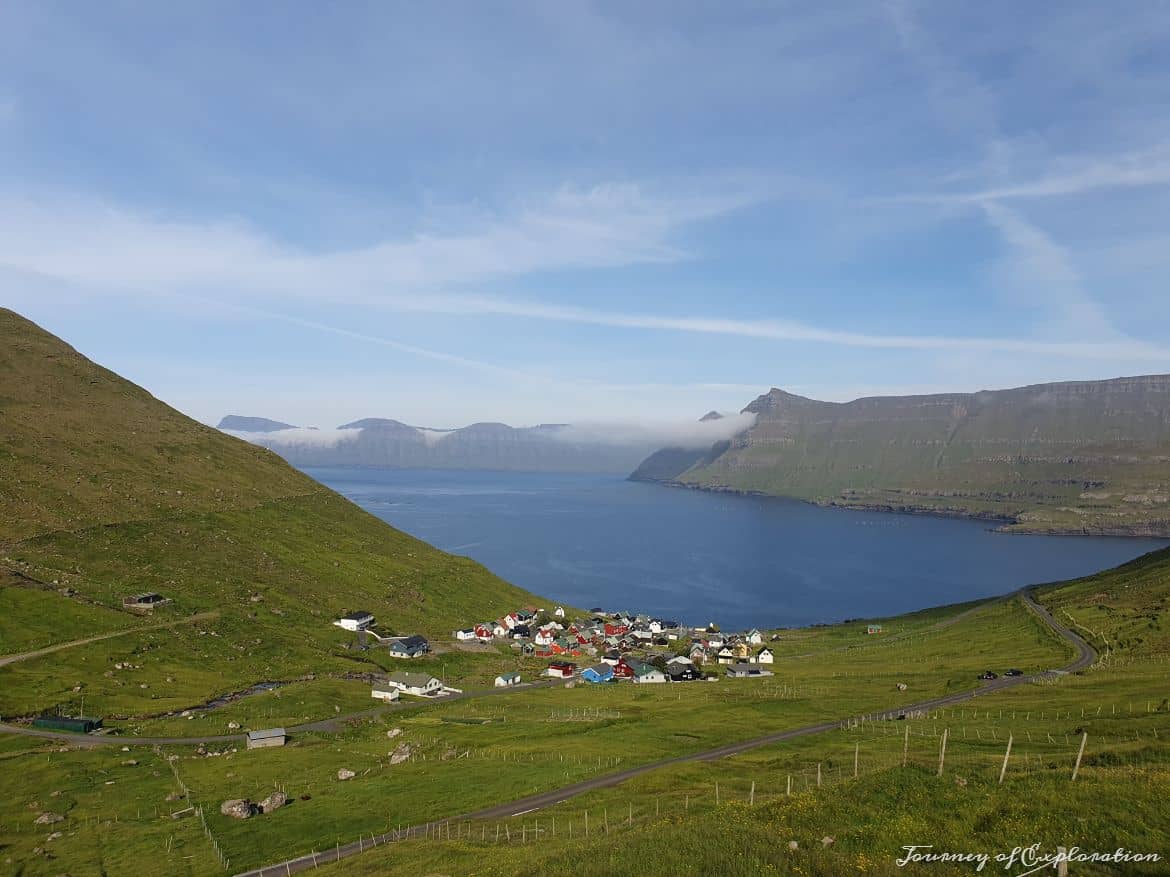
FAROE ISLANDS PHOTOGRAPHY
You can check the best photographs from the Faroe Islands HERE.
Here is a list of the best viewpoint locations on the Faroe Islands where you can enjoy great views.
- View of Mullafossur and Gasadalur village
- Saksun Viewpoint
- Klakkur
- Trælanípa Viewpoint
- Funningur Scenic Point
- Klaksvik Viewpoint
- Kallur Lighthouse Viewpoint
- Gjogv Viewpoint
- Vidareidi Viewpoint
- Tjørnuvík Viewpoint
- Drangarnir Sea Stacks Viewpoint
- Viewpoint over Kvívík
- Elduvik Viewpoint
- Risin og Kellingin viewpoint
- Bøsdalafossur Waterfall Viewpoint
- View over Kaldbaksbotnur
- Eidi Viewpoint
- Memorial Monument (Puffins Viewpoint)
- Viewpoint over Oyrarbakki
- Trollanes Viewpoint
- Oyndarfjarðar Viewpoint
- Trøllkonufingur Viewpoint
- Syðrugøta Viewpoint
- Eastern Ridge Viewpoint
- Mullafossur and Gasadalur Viewpoint
- Nordradalur Viewpoint 1
- Nordradalur Viewpoint 2
- Elduvík Scenic Viewpoint
- Tjørnuvík Viewpoint 2
- Viewpoint over Kollafjørður
- Husavik Viewpoint
- Haldarsvík Viewpoint
- Fuglafjørður Viewpoint
- Torshavn Waterfront Viewpoint
- Skalavik Viewpoint
- Vestmanna scenic point
- Kollafjørður Viewpoint
- Oyrareingir Viewpoint
- Gjogv & Puffin Viewpoint
- Puffin Close Up Viewpoint
- Sandur Viewpoint
- Kaldbaksfjørður viewpoint
- Norðadalsskar viewpoint
- Gasadalur village Viewpoint
- Viðareiði Village Viewpoint
- Torshavn Viewpoint 1
- Torshavn Viewpoint 2
- Leynasandur Viewpoint
- Kongaminnið
- Midvagur Viewpoint
- Bøur panoramic viewpoint
- Bour Viewpoint
- Bour Viewpoint 2
- Sandavagur Viewpoint
- Sandavagur Viewpoint 2
- Dalur Viewpoint
- Dalur Viewpoint 2
- Skarvanes coastline Viewpoint
- Skarvanes coastline Viewpoint 2
- Sandsvatn Viewpoint
- Skopun Viewpoint
- Hvalvik Viewpoint
- Velbastaður Viewpoint
- Syðradalur Viewpoint
- Torshavn Old Town Viewpoint
- Kvivik Falls Viewpoint
You can check these viewpoint locations and the best photo spots on the island in the following map.
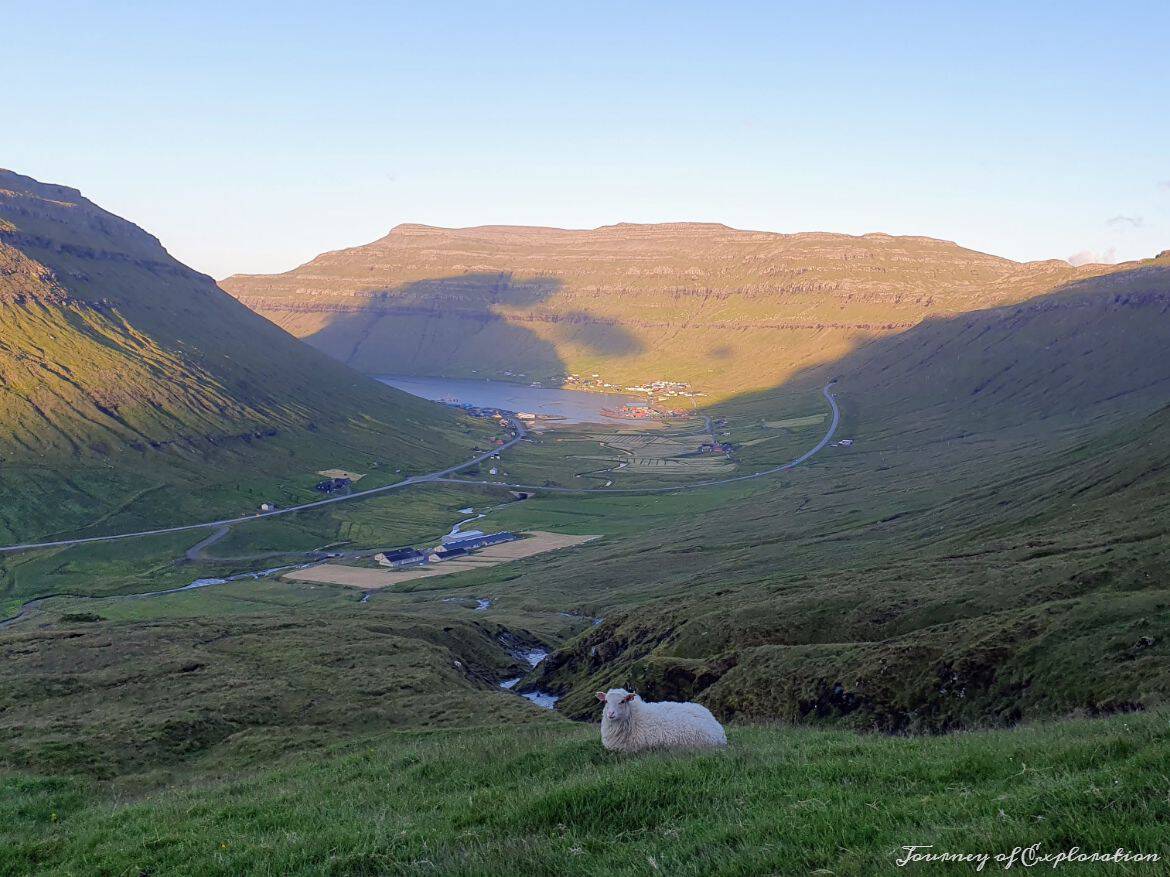
FAROE ISLANDS ACTIVITIES
Faroe Islands is a great place for outdoor activities. Some of the best activities to do in the Faroe Islands include:
Water Activities
- Fishing: Join a fishing tour to catch local fish in the Faroese waters. You can arrange fishing trips from various locations through this website.
- Snorkelling or diving: You can experience the exciting seabed of the Faroes Islands with North Atlantic Dving.
- Sailing/Boat Tours: For more information about the various boat tours, check HERE
Hiking
The Faroes Islands offer numerous hiking trails and coastal paths, ranging from easy strolls to challenging treks. Hikers should wear appropriate footwear and be prepared for changing weather conditions.
Some of the best hikes in the Faroes include:
- Kallur Lighthouse Hike: Located on Kalsoy Island, this is one of the most popular hikes in the Faroes. offering breathtaking views of the surrounding islands and the North Atlantic Ocean.
- Duration: 2 to 2.5 hours hours round trip
- Difficulty: Moderate
- Cost: 200DKK
- Lake Sørvágsvatn Hike: A popular hike that leads to a viewpoint where Lake Sørvágsvatn appears to float above the ocean, offering an optical illusion and stunning views.
- Duration: 1.5 to 2 hours roundtrip
- Difficulty: Moderate
- Cost: 200DKK
- Klakkur Hike: This short hike will take you to the top of the mountain which provides amazing views of the surrounding islands and the town of Klaksvík.
- Duration: 1.5 to 2 hours roundtrip
- Difficulty: Easy to Moderate
- Cost: Free
- Slættaratindur Hike: Ascend the highest peak in the Faroe Islands for panoramic views. The first part is very steep and then it slowly levels out. You can leave the car in a small car park by the side of the road (limited spaces).
- Duration: 3-4 hours round trip
- Difficulty: Challenging
- Cost: Free
- Mount Villingadalsfjall & Cape Enniberg Hike: Mount Villingadalsfjall is the third highest summit in the Faroe Islands, located near Viðareiði. This hike is quite steep with no defined path, but blue poles. It offers outstanding views of the surrounding islands. It’s a difficult hike, but you don’t need to go all the way to the top to enjoy the views.
- Duration: 3-4 hours round trip
- Difficulty: Difficult
- Cost: 200DKK
- Saksun Hike: This is an easy hike to enjoy the beautiful lagoon and black sandy beach of Saksun. Better on low tide.
- Duration: 1h roundtrip
- Difficulty: Easy
- Cost: Entrance Fee
More information about the various hikes in the Faroes can be found here.
For guided hike tours, you can book through the following website HERE
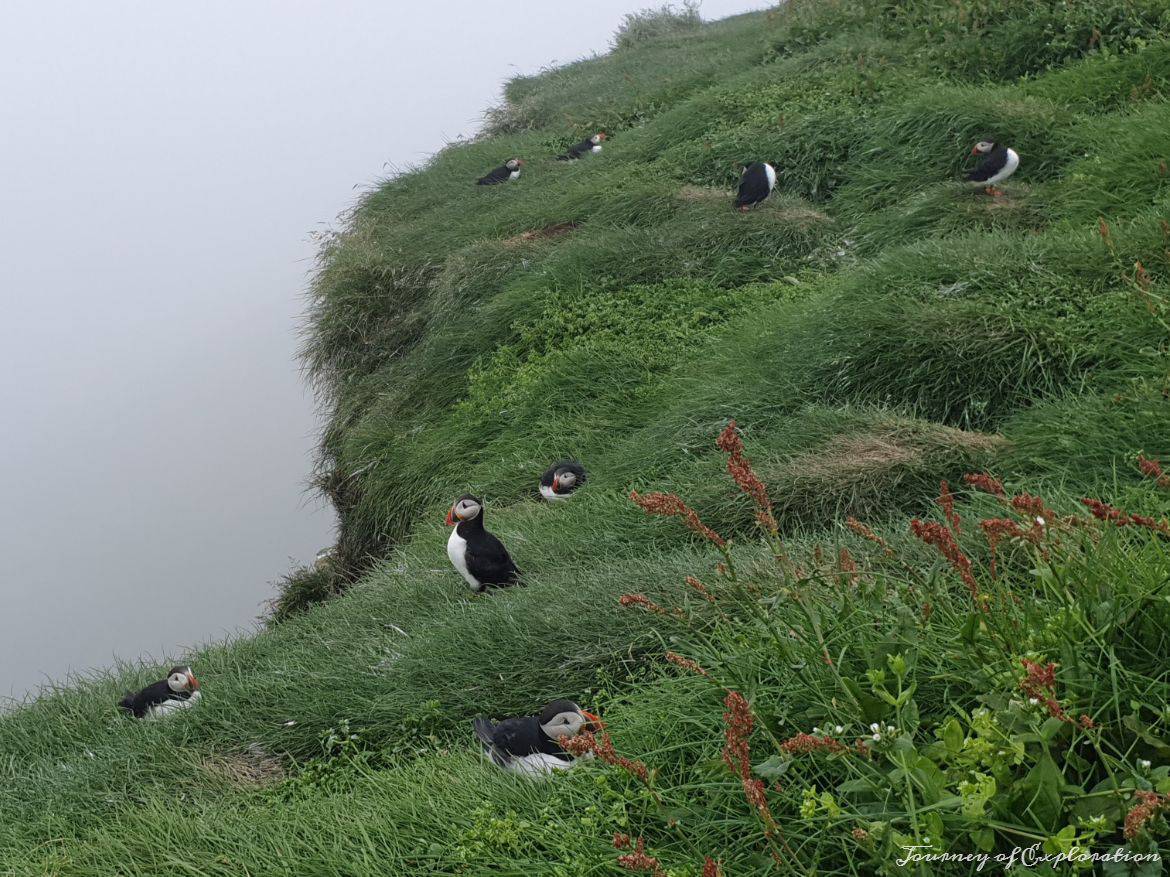
Wildlife watching
- Birdwatching: Faroe Islands is a great place for birdwatching, with opportunities to spot different types of seabirds, like puffins, gannets, fulmars, oystercatchers, guillemots, razorbills, kittiwakes, manx shearwater, arctic terns, arctic & great skua and the common snipe. The oystercatcher is the national bird of the Faroe Islands, and can be easily spotted by its unique sound. The best places for birdwatching are:
- Mykines Island: Mykines is famous for its large puffin colonies, where you can see these charming seabirds up close. The best time to see puffins is during the breeding season from May to August.
- Vestmanna Bird Cliffs: You can join a boat tour to view dramatic cliffs and seabird colonies.
- Nolsoy Island: You can see puffins
- Gjogv: You can also spot puffins on the cliffs and other seabirds.
Some of the best wildlife tours in the Faroe Islands include:
- Vestmanna Bird Cliff Tour: The boat tour to the birdcliffs near Vestmanna is one of the most popular tourist attractions in the Faroe Islands. On this 90 minutes tour you will get close to various seabirds, and you will sail into deep grottos and around high sea stacks.
- Mykines Guided Tour: When arriving at Mykines by boar (or helicopter), it is mandatory to book a guided tour to hike on the island and see the puffins. It is not allowed to hike on your own. The hike starts at the schoolyard upon arrival on the island. The tour is 2-3 hours.
Horseriding
A unique experience to ride the beautiful Icelandic or Faroese horses amongst stunning landscapes. There are a few companies like the ones below offering horseriding tours:
- Berg Hestar (Horseriding): Berg Hestar offer horse riding tours in and around the capital,# Tórshavn. The tours vary in difficulty and price range.
- Fjallaross: The only company offering horseriding with Faroese Ponies.
Festivals
- Ólavsøka: The Faroe Islands’ national day, celebrating St. Ólav’s Day with parades, traditional music, dance, and various cultural events. It’s a major event with a festive atmosphere throughout Tórshavn.
- Date: July 29 – 30
For Kids
- National Museum of the Faroe Islands: The museum has interactive exhibits and artefacts that can be engaging for children, providing information about Faroese culture and history.
- Føroya Sjósavn (Faroese Aquarium): A small but fascinating aquarium with local marine life, including fish and sea creatures found around the islands.
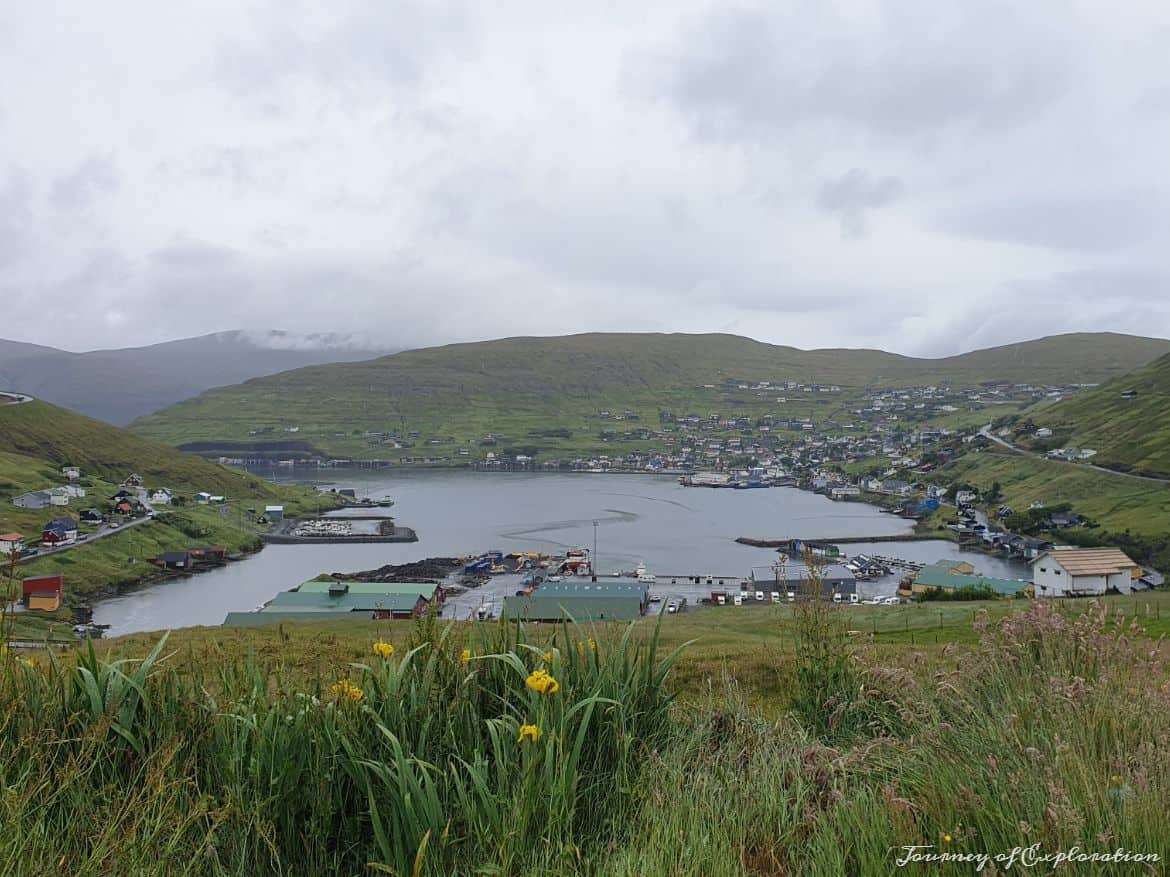
FAROE ISLANDS TOURS
Boat Tours
There are various boat tours during the summer season, and excursions by boat to explore the islands’ coastline, sea stacks, and remote areas.
- Drangarnir Sea Stacks Boat Tour: 1h boat tour from Sorvagur to Bour, Mulafossur Waterfall, Tindhólmur and Drangarnir.
- Sightseeing Around Nólsoy to see Puffins: A 2h boat trip from Torshavn to the Eastern side of Nólsoy, sail past two lighthouses and witness the majestic birdlife – including puffins.
Guided Tours
- Faroe Islands Highlights Tour: Discover the main sights of the Faroe Islands in a day with this small-group highlights tour.
More information about tours in the Faroes can be found here.
VIRTUAL TOUR OF FAROE ISLANDS
Check the following video slideshow to get further inspiration to visit the Faroe Islands 🙂
SHOPPING IN FAROE ISLANDS
In the Faroe Islands, the best places for shopping are Tórshavn and to a lesser extent Klaksvík.
Torshavn has a range of shops that sell Faroese designs, souvenirs and locally made items. One of the best places to shop for souvenirs is H. N. Jacobsens Bókahandil, in Torshavn.
Tórshavn is also home to a large shopping mall, called SMS. It includes clothing stores, restaurants and a large grocery store.
Some unique things to buy in the Faroe Islands include:
- Traditional Wool Items: Faroese knitwear, including sweaters, scarves, and hats featuring traditional designs.
- Local Handicrafts like pottery, jewellery and wood carvings featuring Faroese designs.
- Viking-themed souvenirs
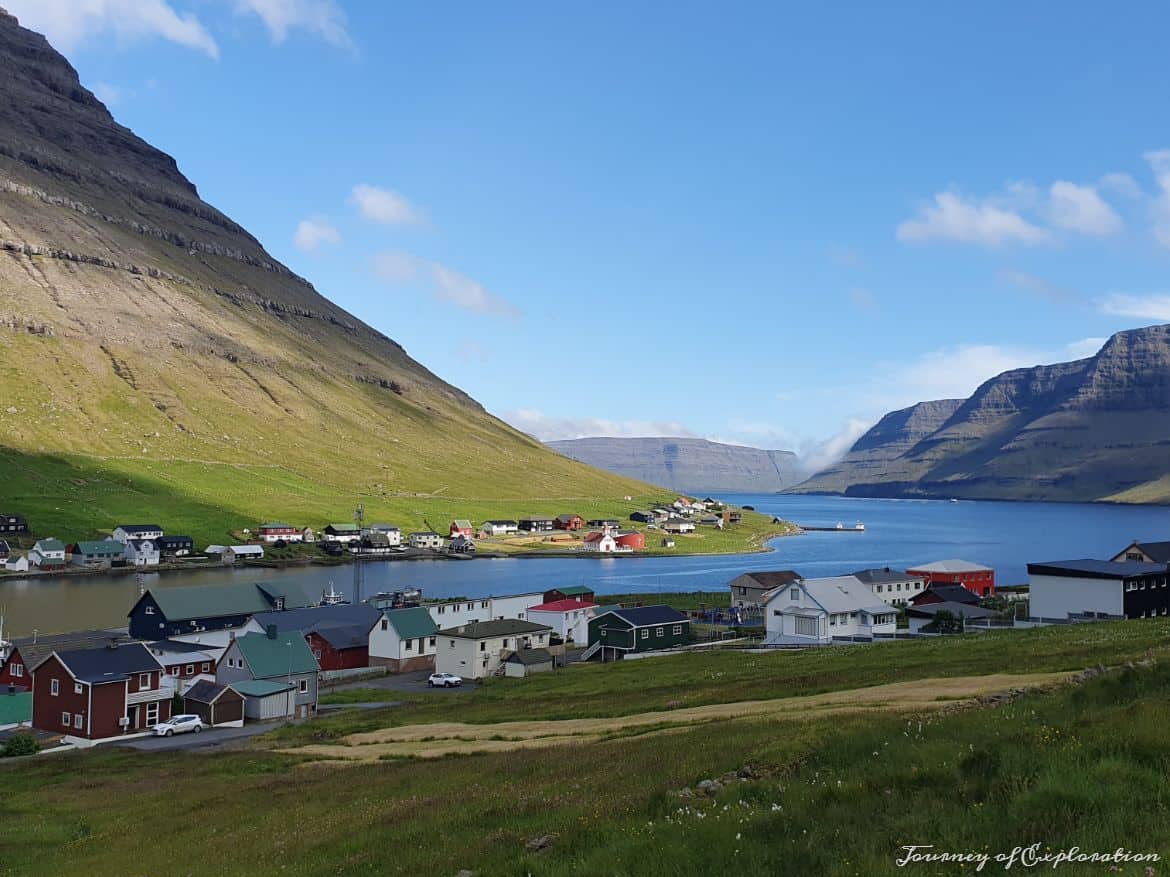
FURTHER READING
Other useful websites for more information about the Faroe Islands:
- Faroeislands: The official website of Faroe Islands
- Visit Faroe Islands: This is the best website for comprehensive information on the Faroe Islands’ s attractions, accommodation, activities, events, and travel tips.
- Guide to Faroe Islands: It provides good information and advice for travelling to the Faroe Islands including tours and vacation packages
Some good travel guides to buy before you visit Faroe Islands:
- Faroe Islands (Bradt Travel Guides): The best english speaking guide for the Faroe Islands
- Flights: I always use Skyscanner as my first choice as it’s so easy to use and you can search best deals by month. Google Flights is another very good search engine.
- Accommodation: I always use Booking.com as my first choice, as it offers a great choice of accommodation at affordable prices and it’s so easy to use. Airbnb is a great alternative for homes and apartments to rent by real homeowners. Also, this site offers a list of accommodation options in the Faroe Islands that you can contact directly.
- Ferries: You can check ferry timetables between the islands on this site.
- Car Rental: I always check Skyscanner for the cheapest car rental options. Discover Cars is also a good and easy-to-use website with great prices.
- Public Transport: You can use this website to check bus timetables on the island.
- Day Trips & Tours: Viator provides the most comprehensive list of tours and you can book directly with them. GetYourGuide is also a great place to search for tours & activities to do.
- Travel Insurance: SafetyWing is a great choice for long-term travellers and digital nomads. Alternatively, you can use one of the price comparison websites for cheaper quotes.
- Disclosure: This post may contain affiliate links, and at no extra cost to you, I may receive a small commission if you make a purchase. I recommend only products and companies I use and the income goes to keeping this site running and ad-free.

